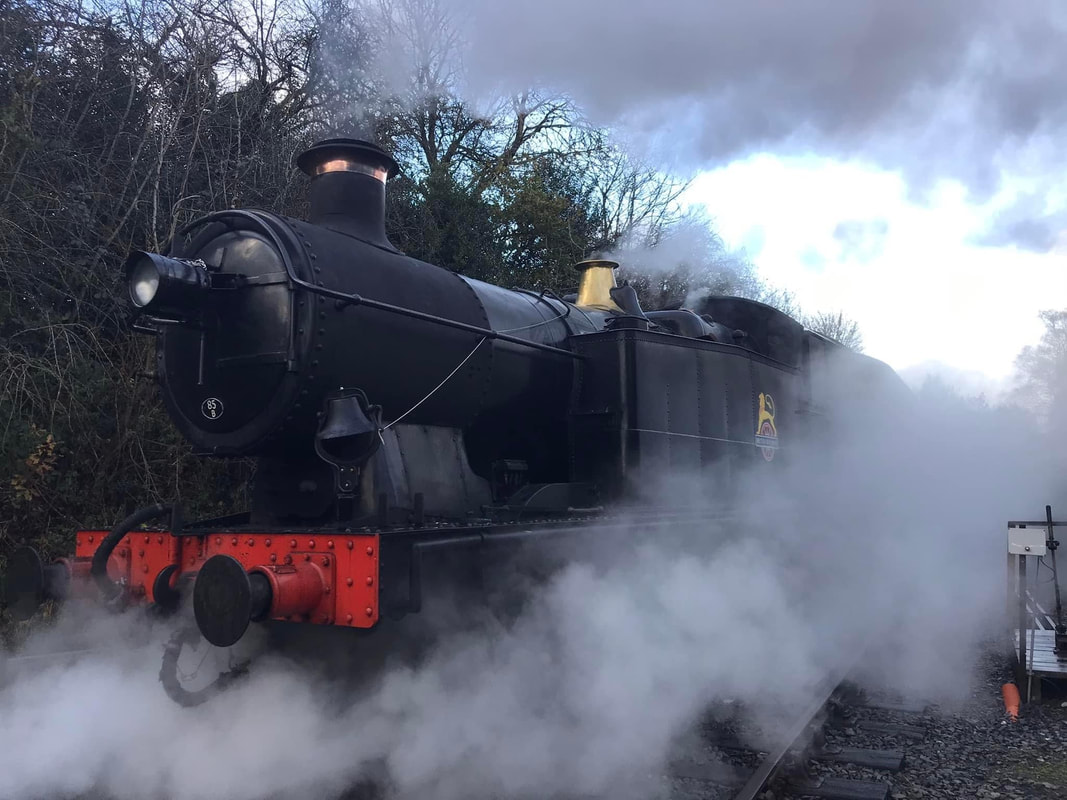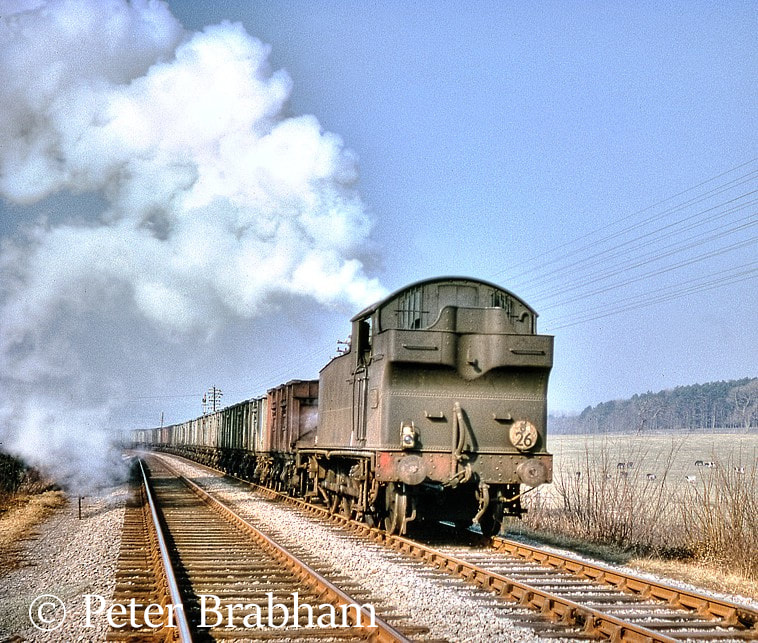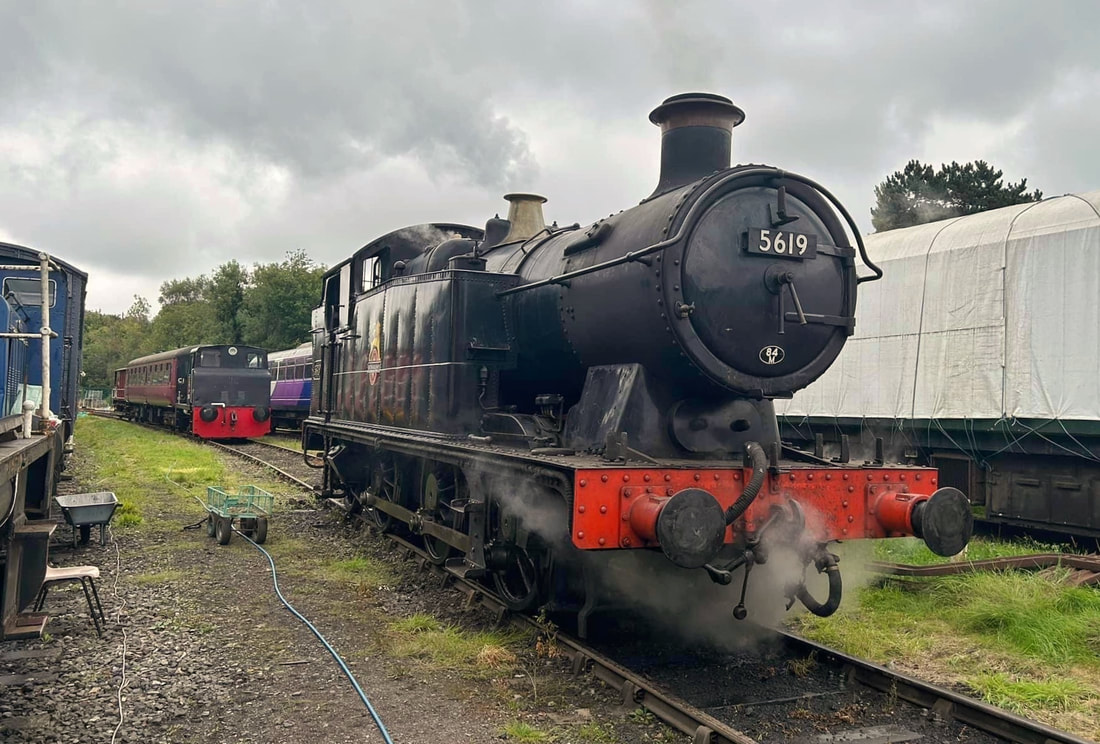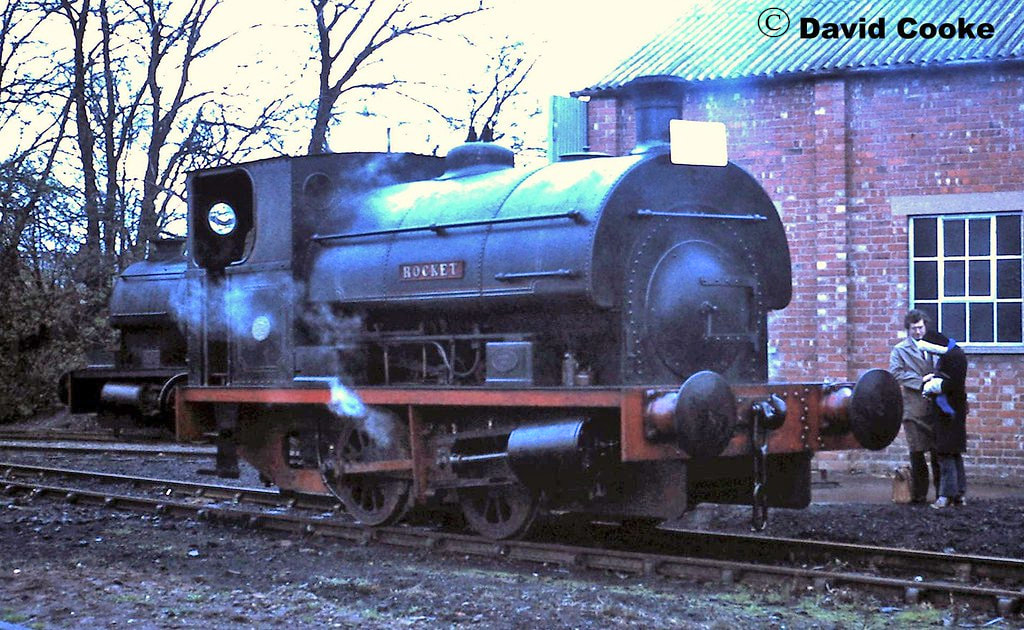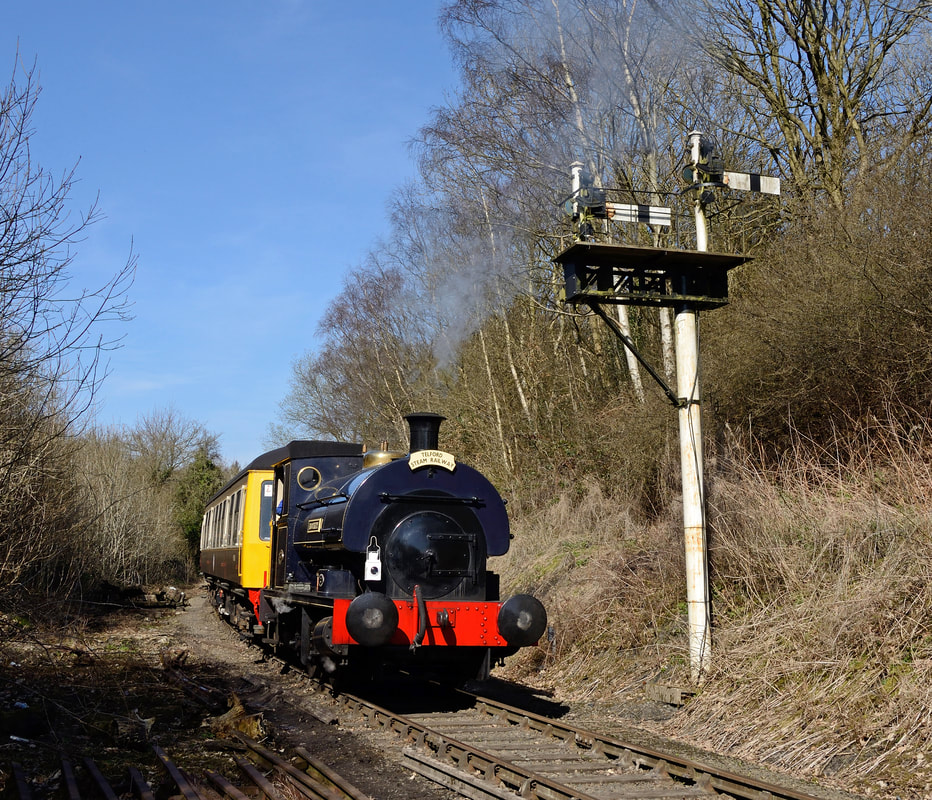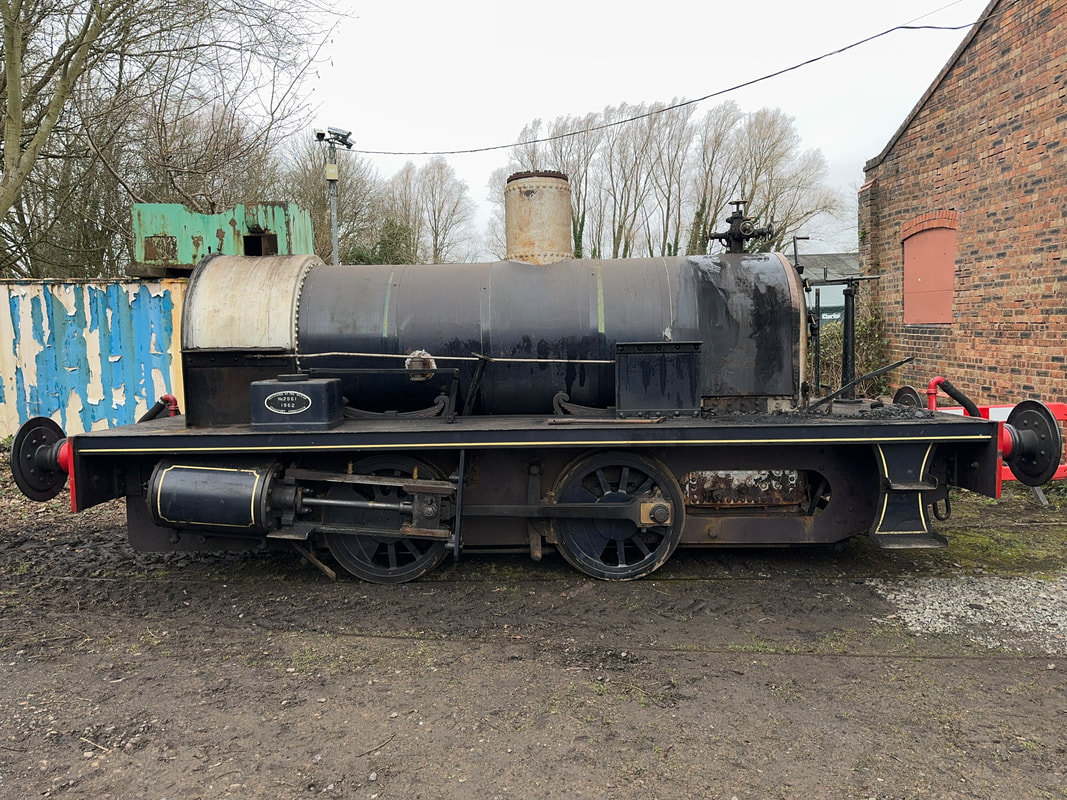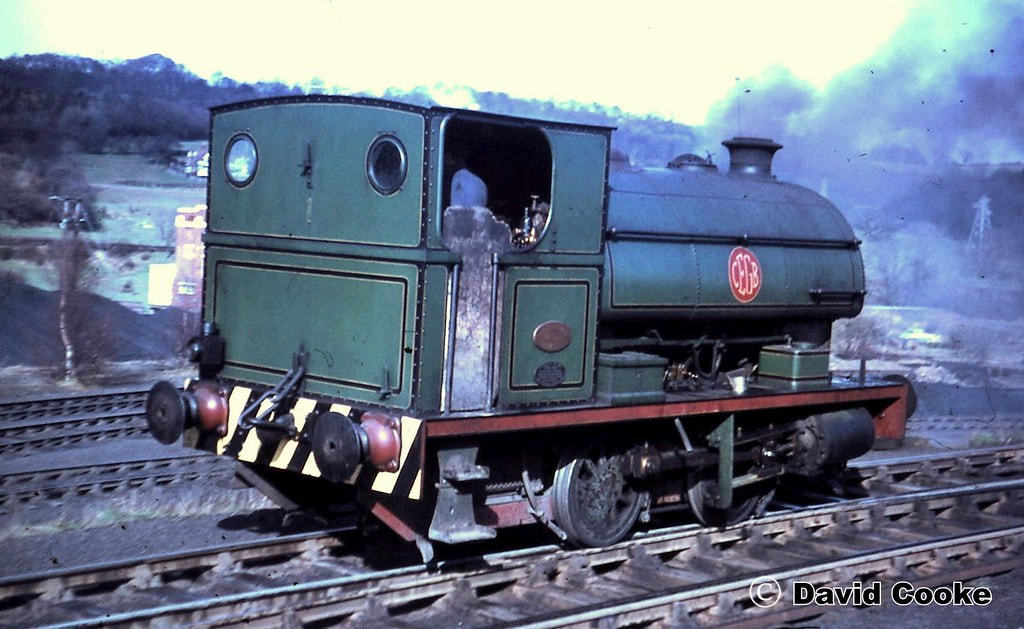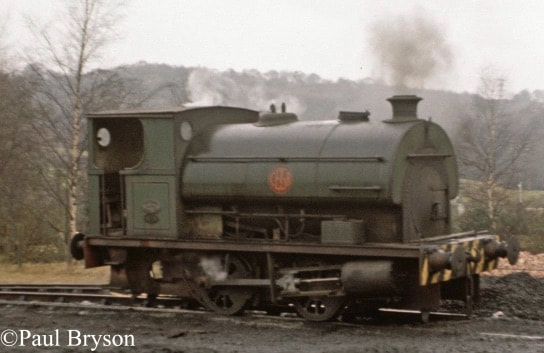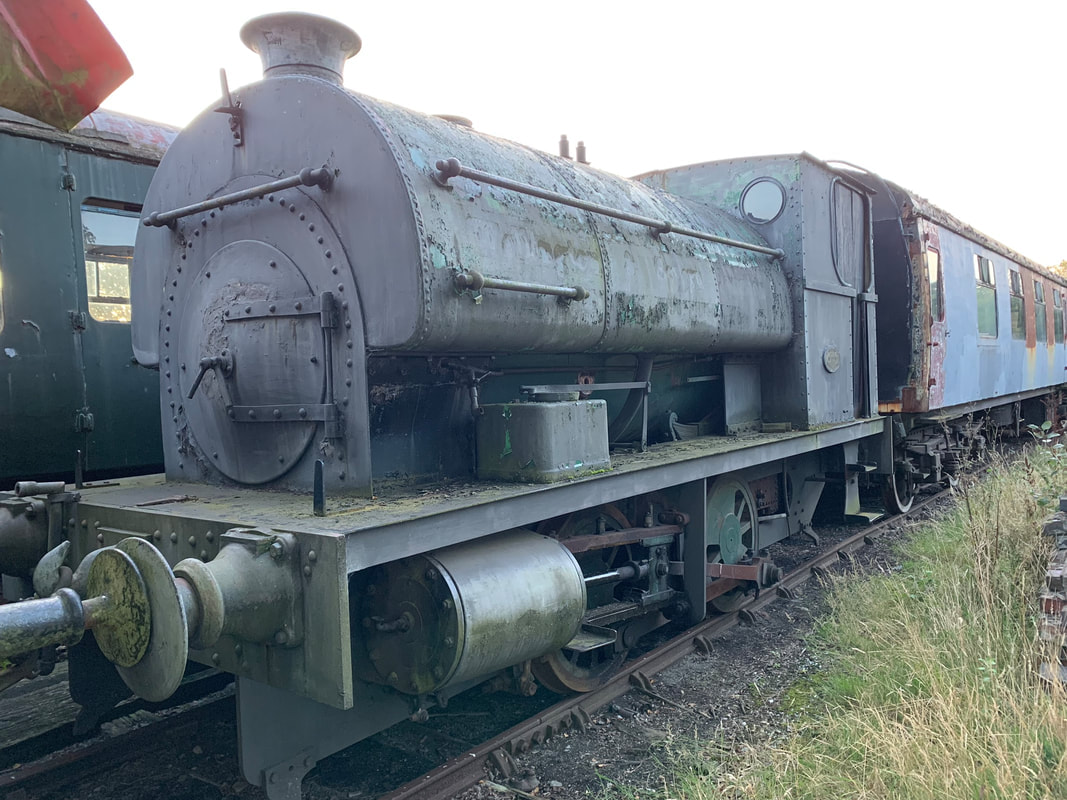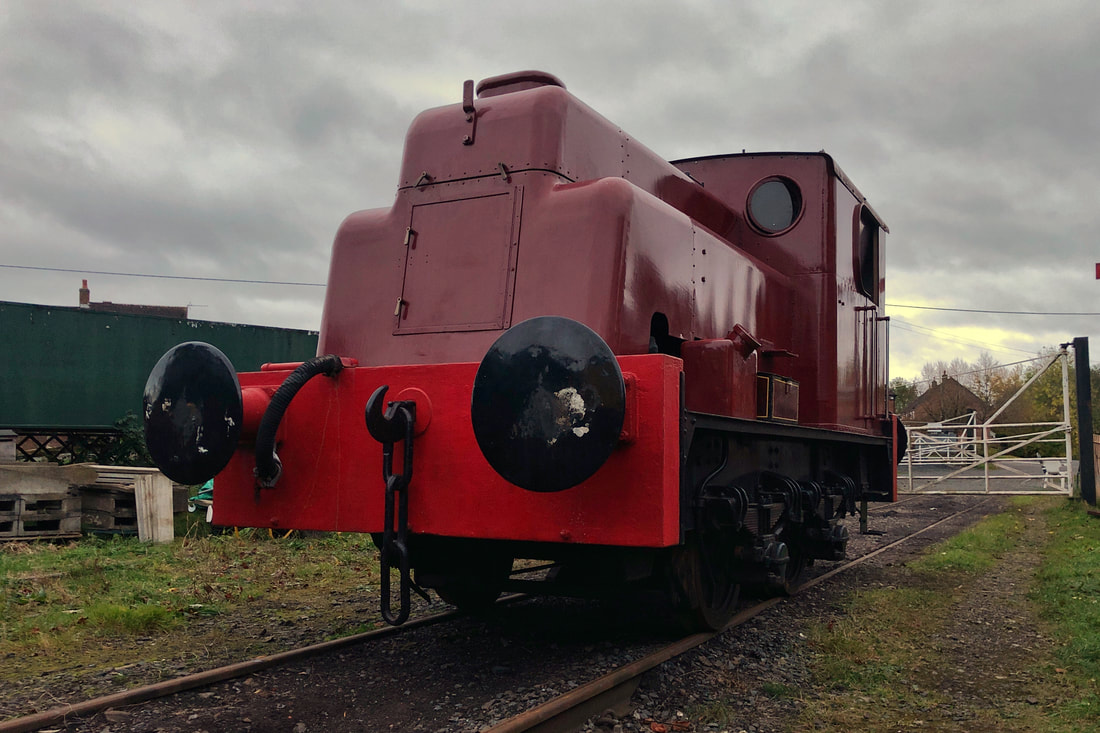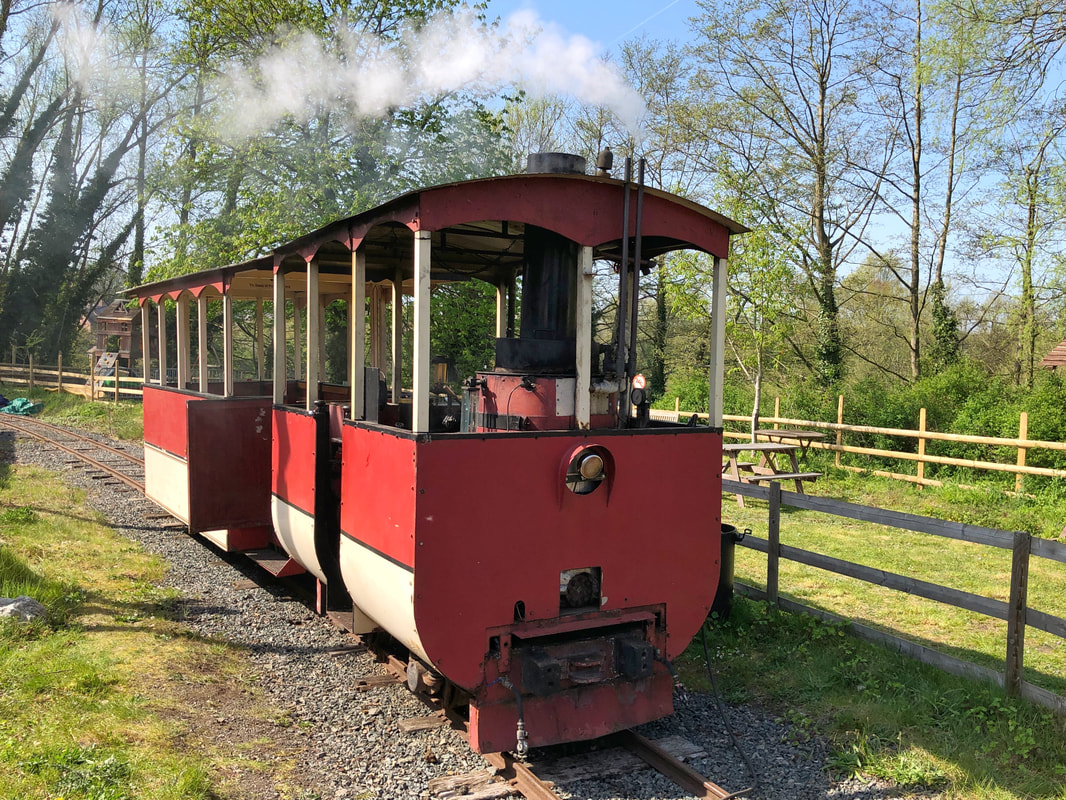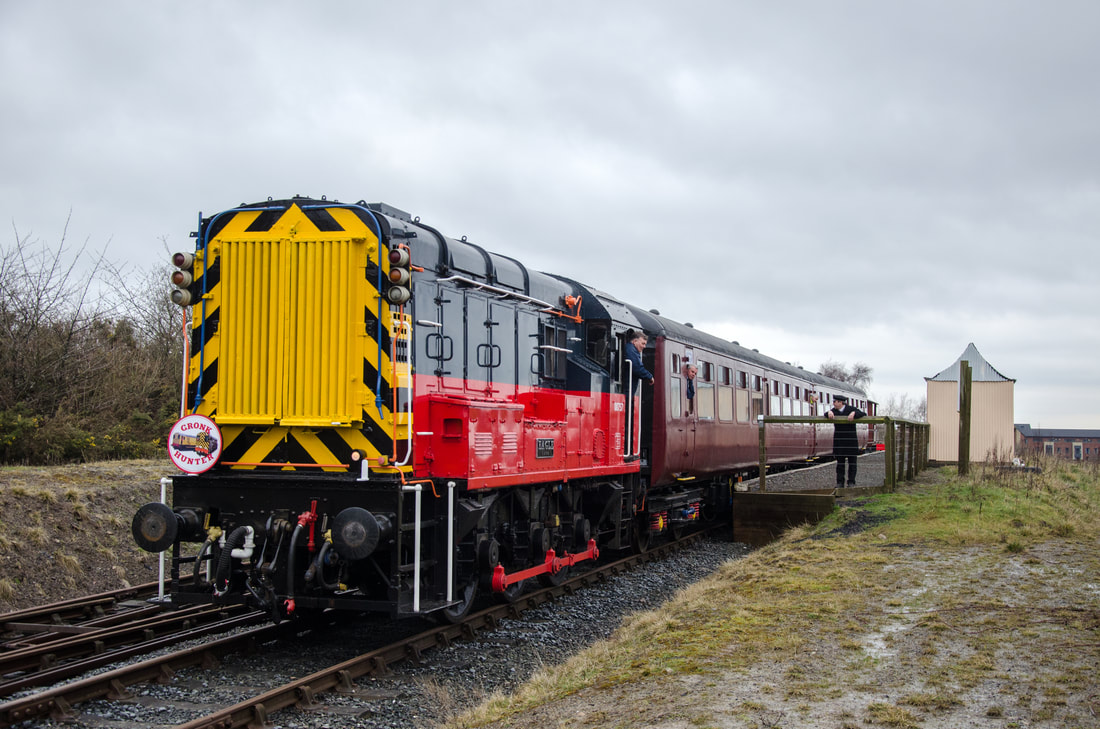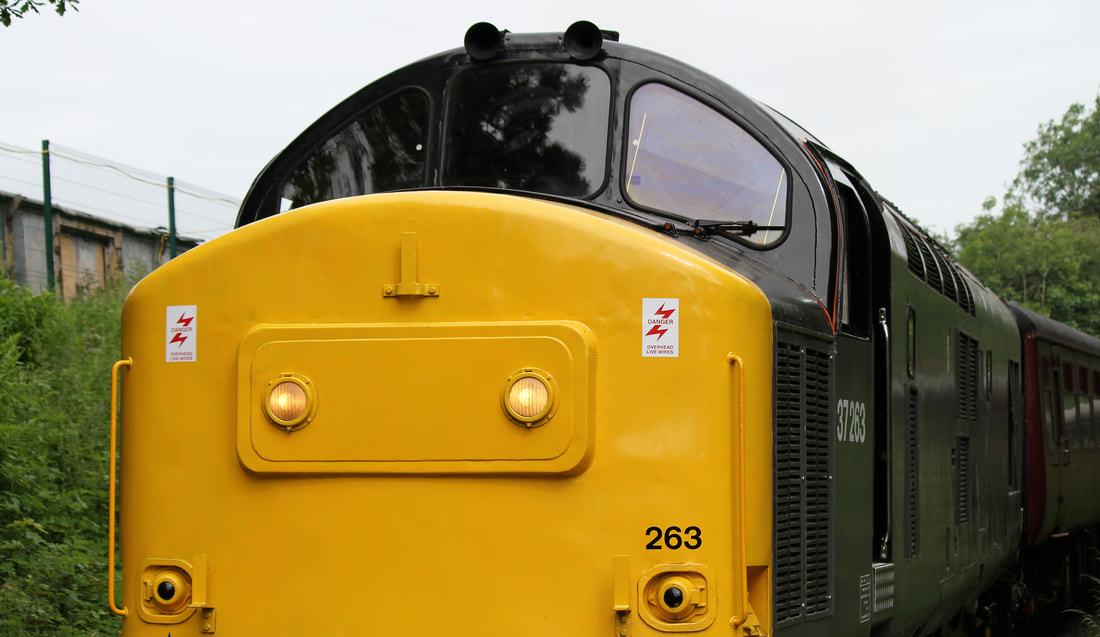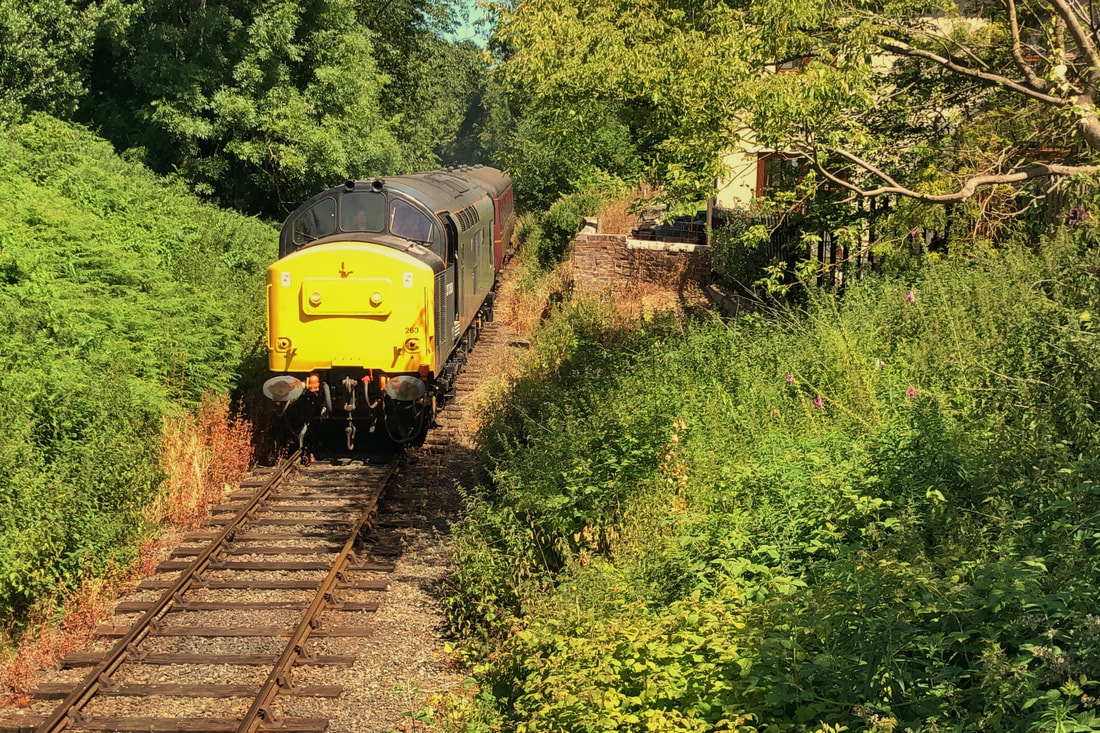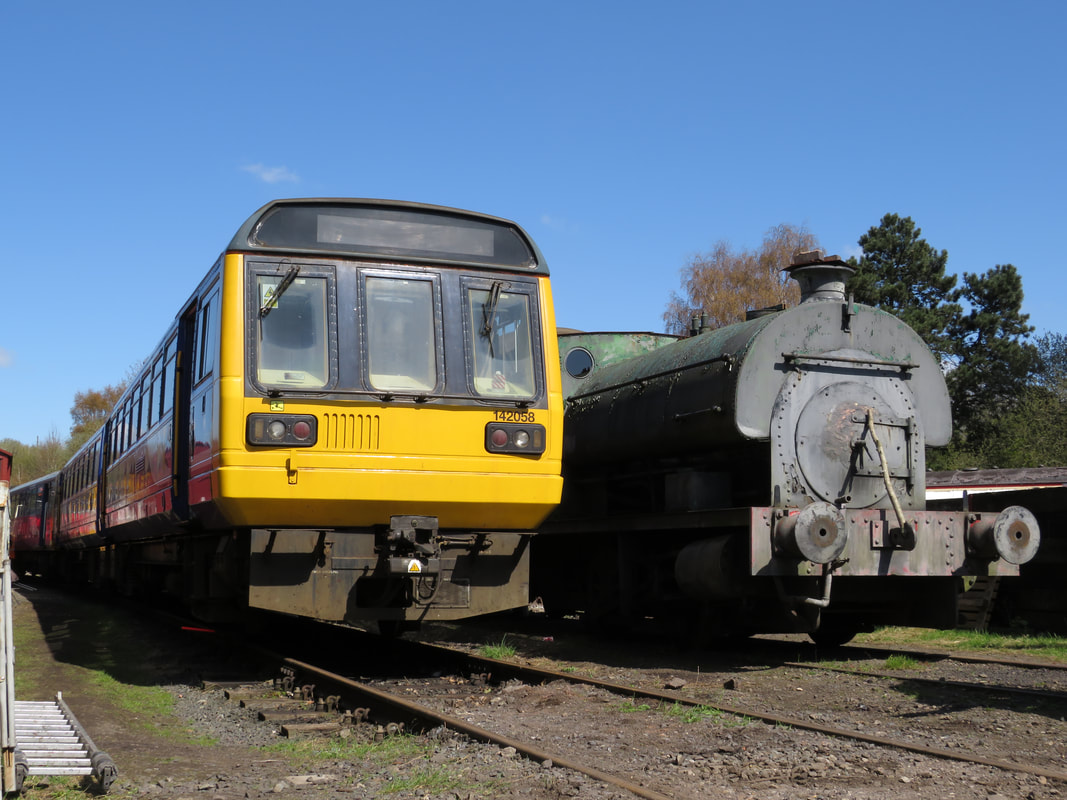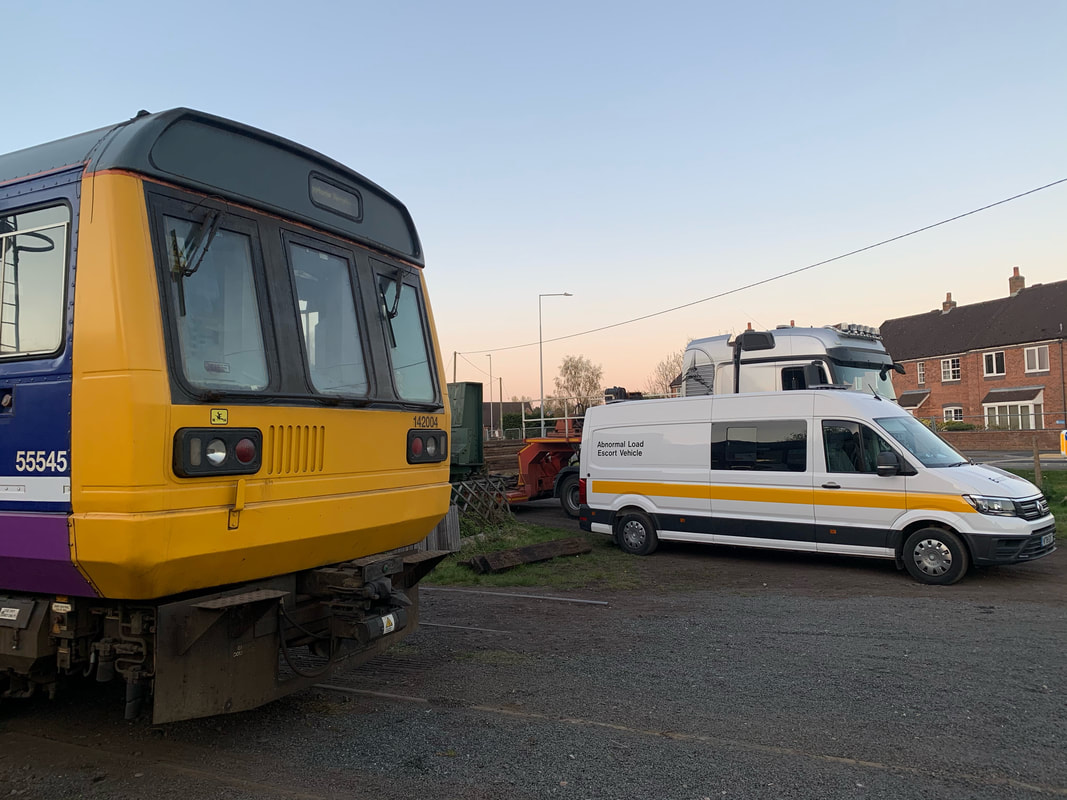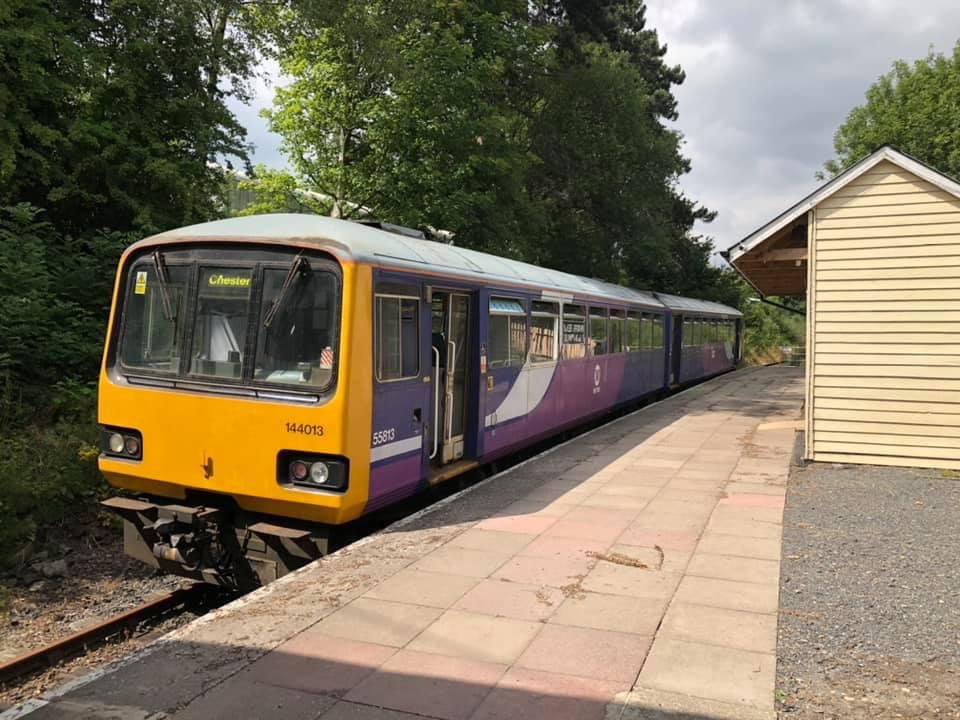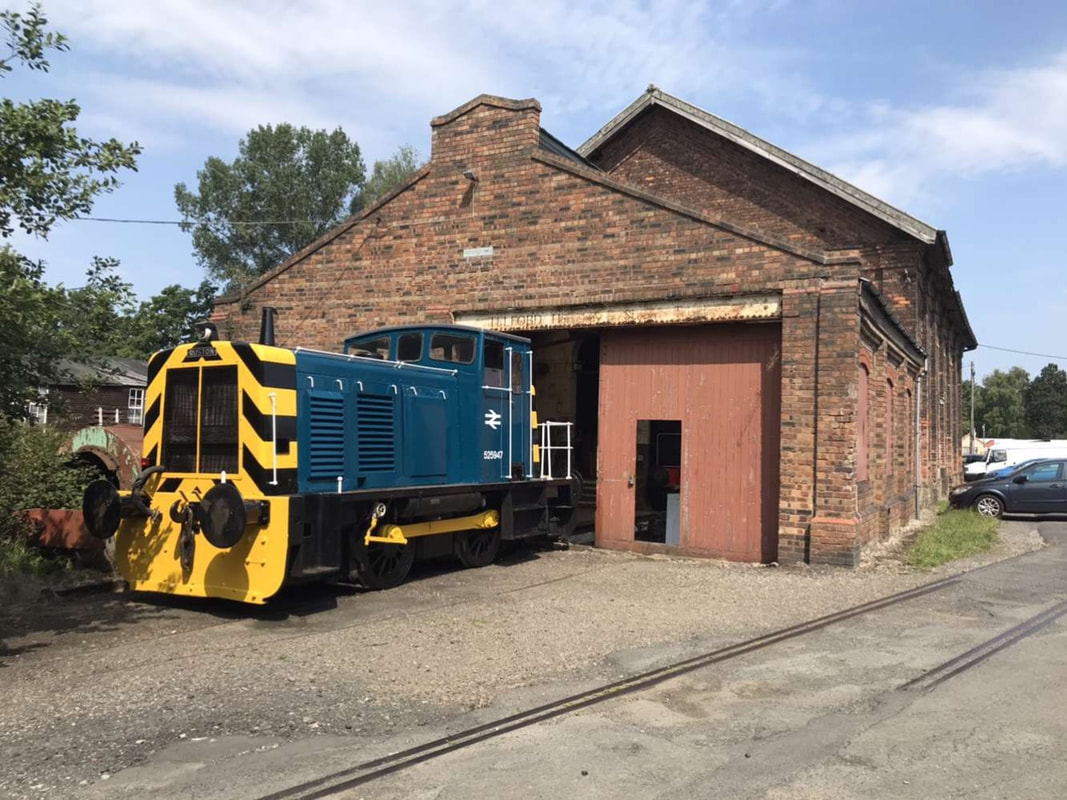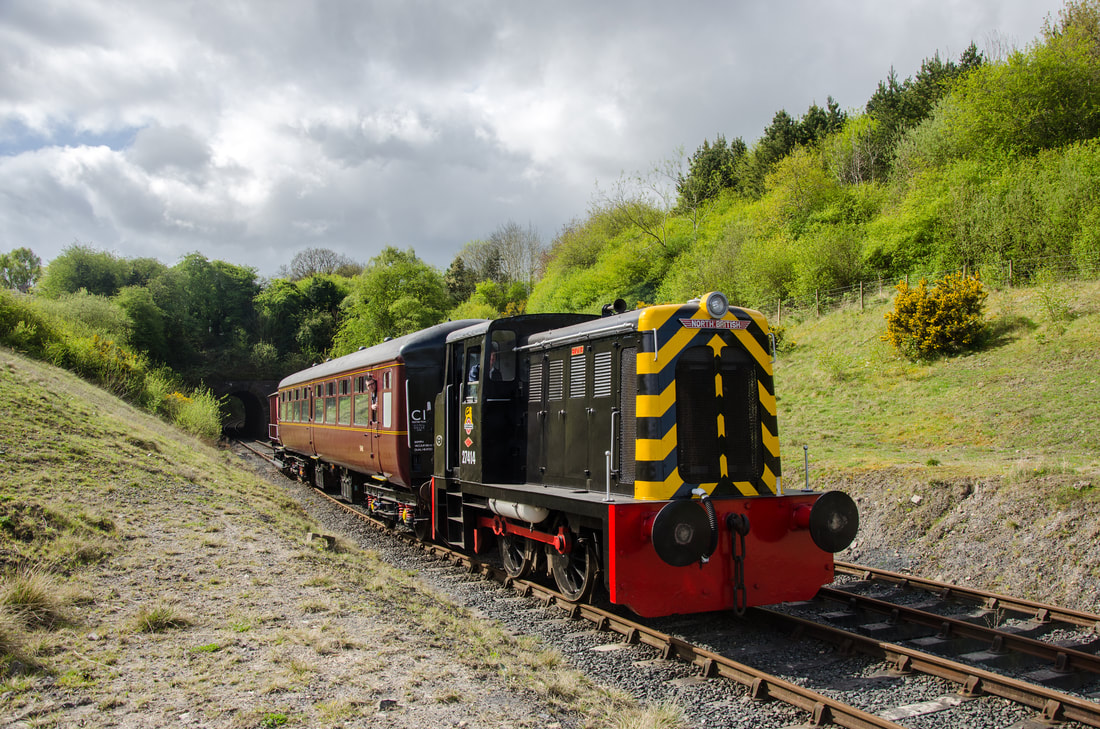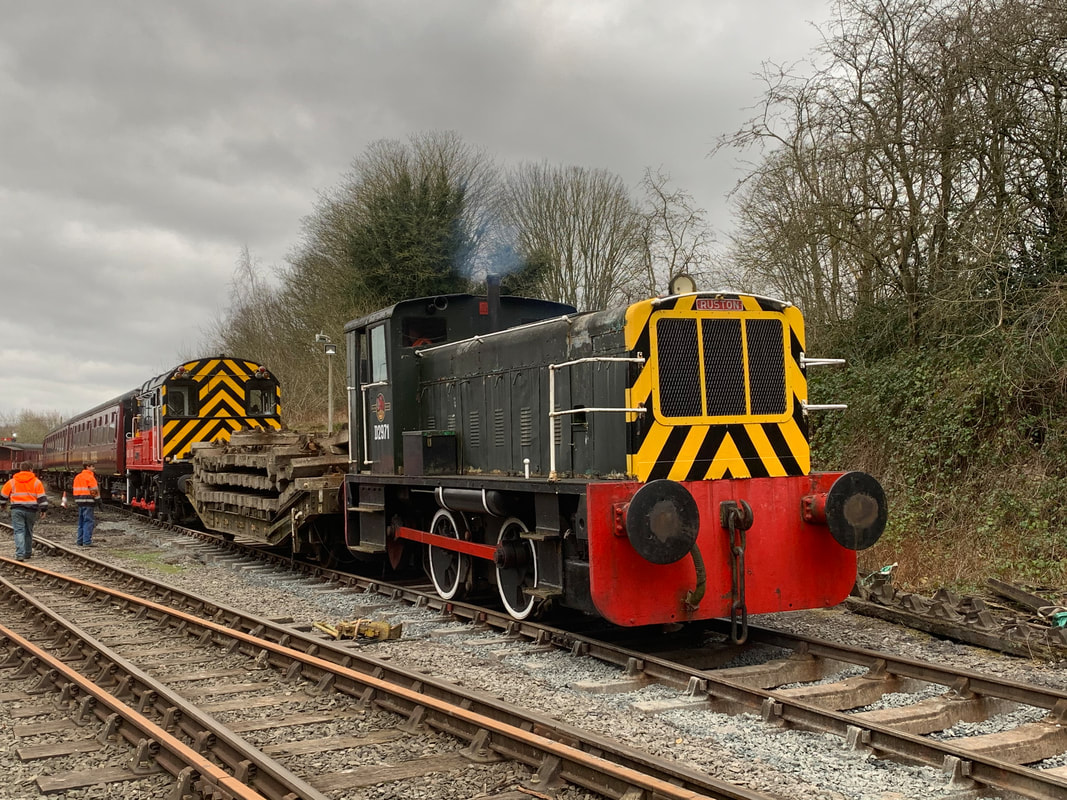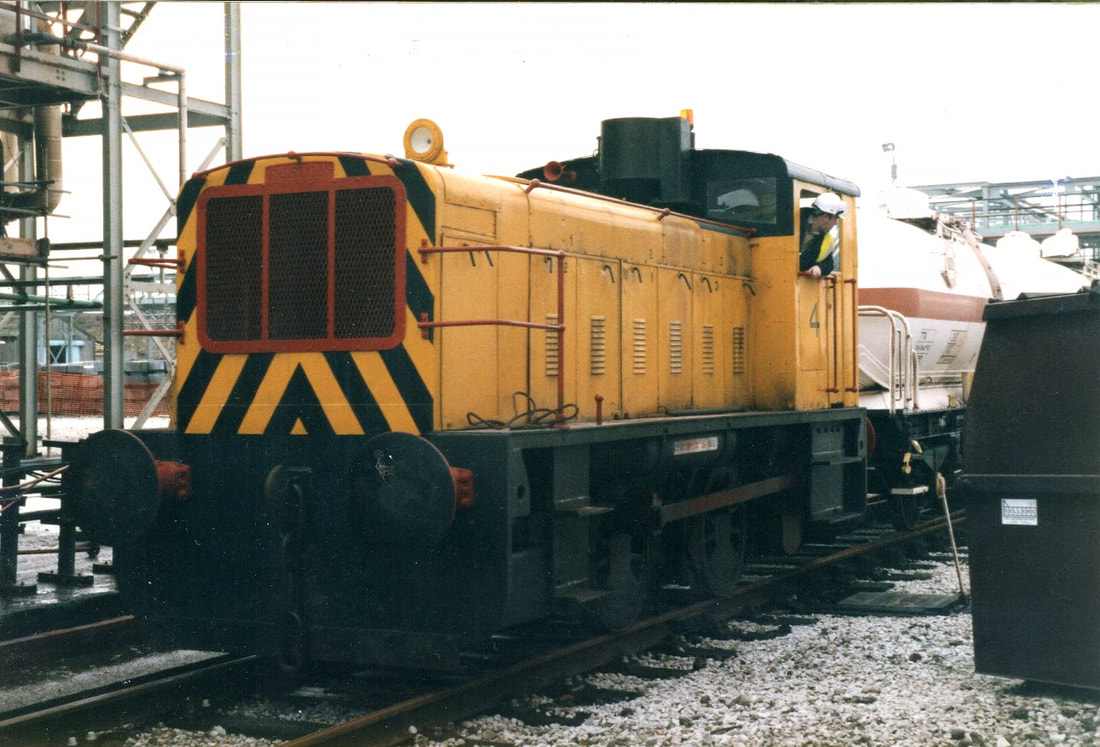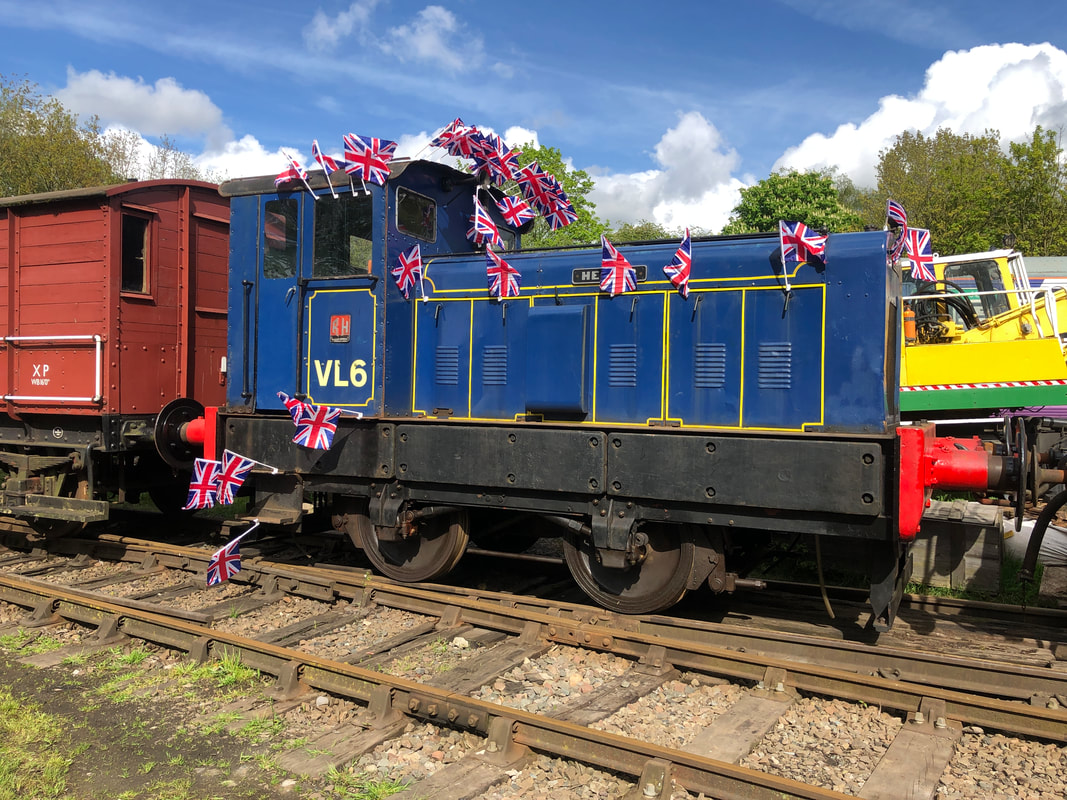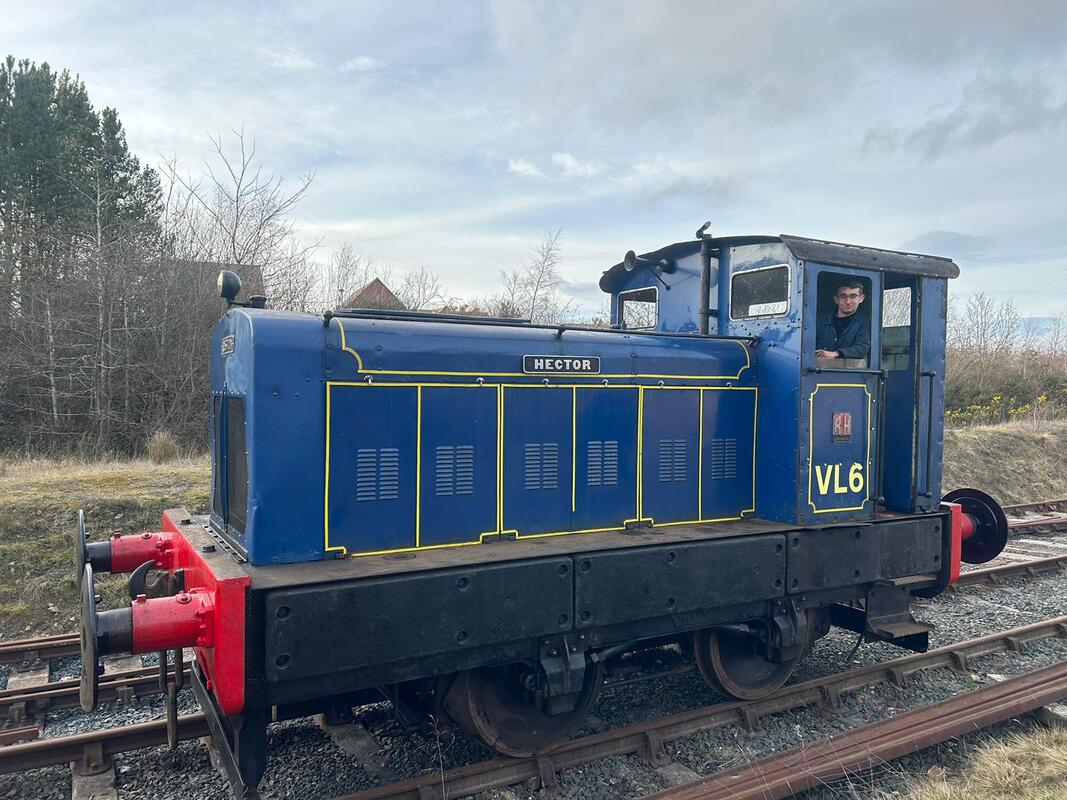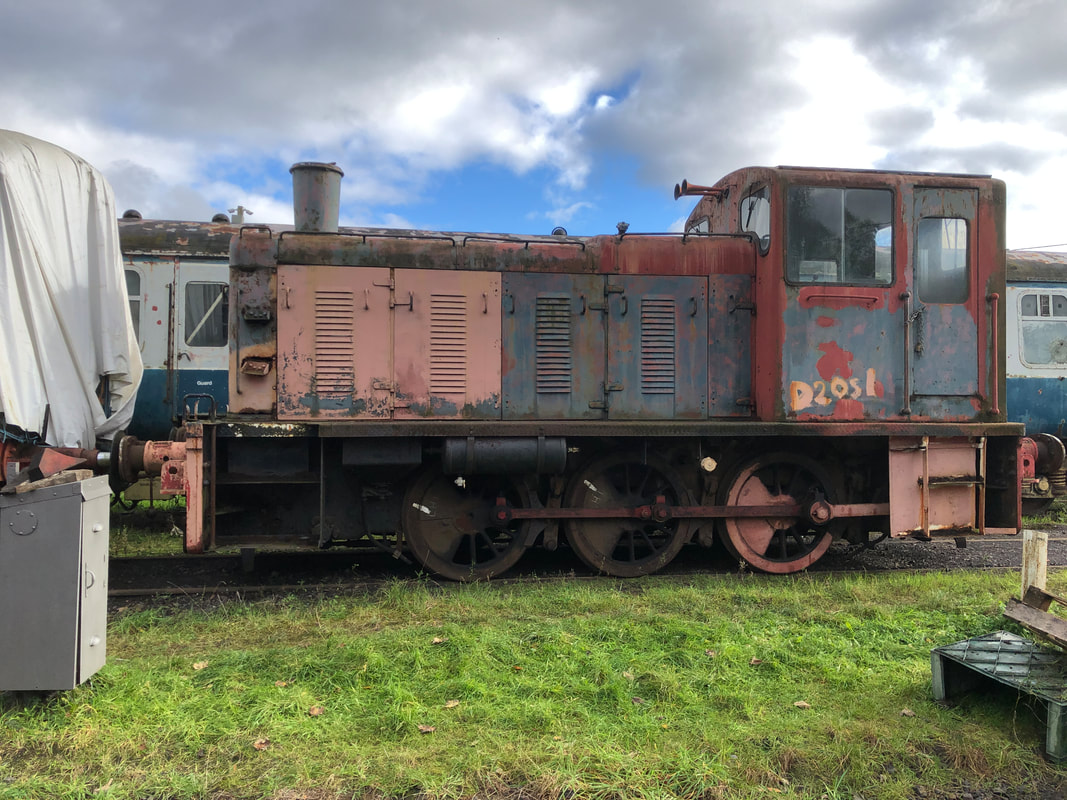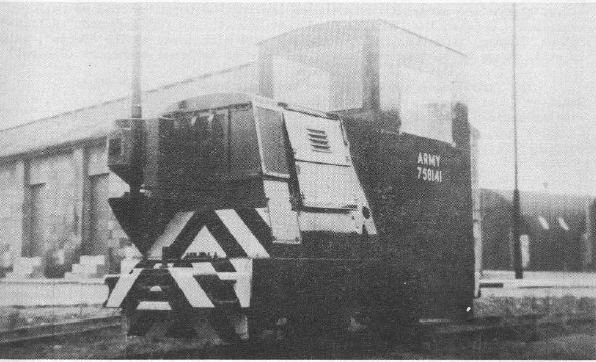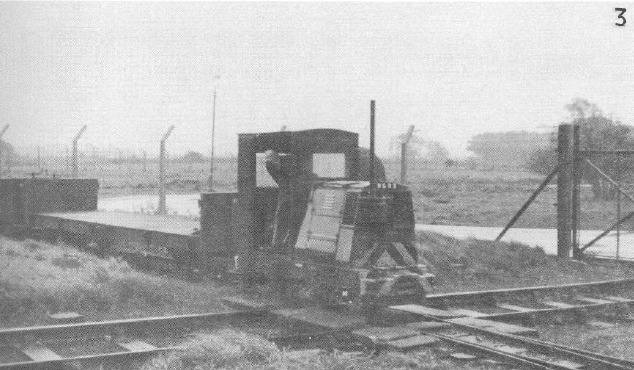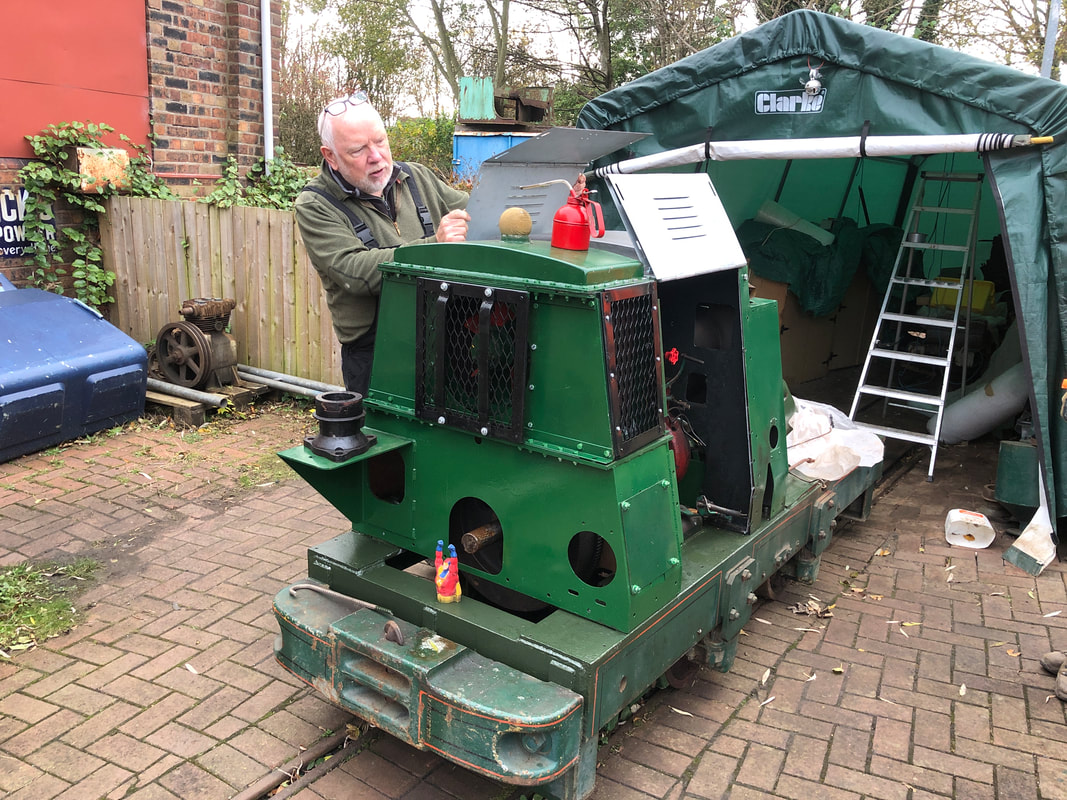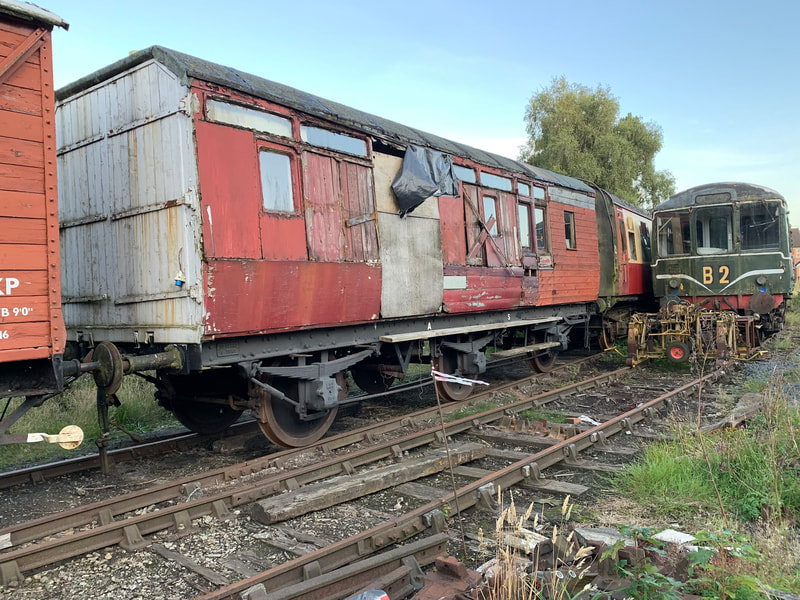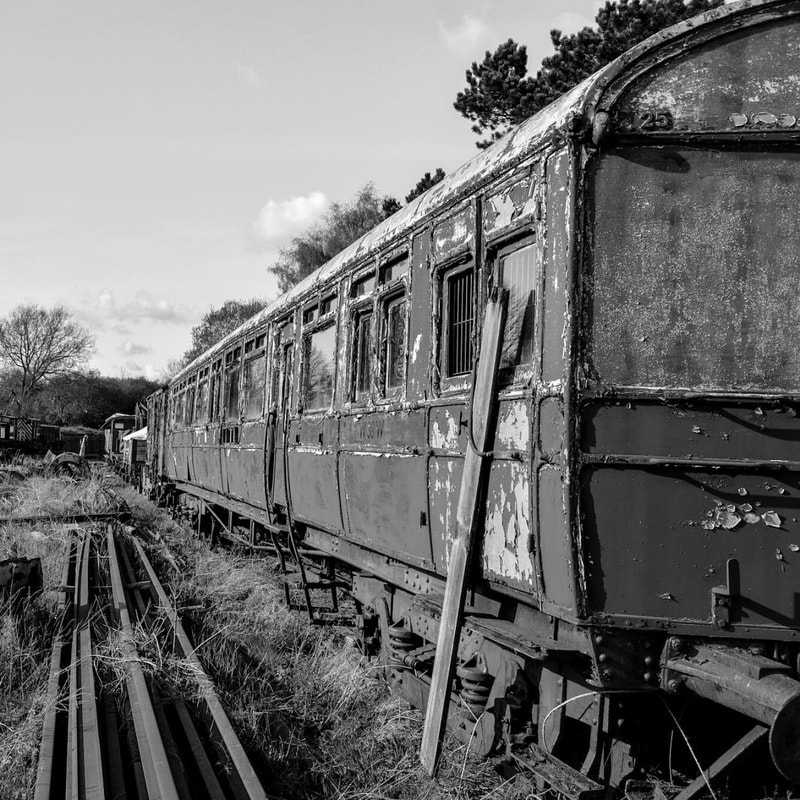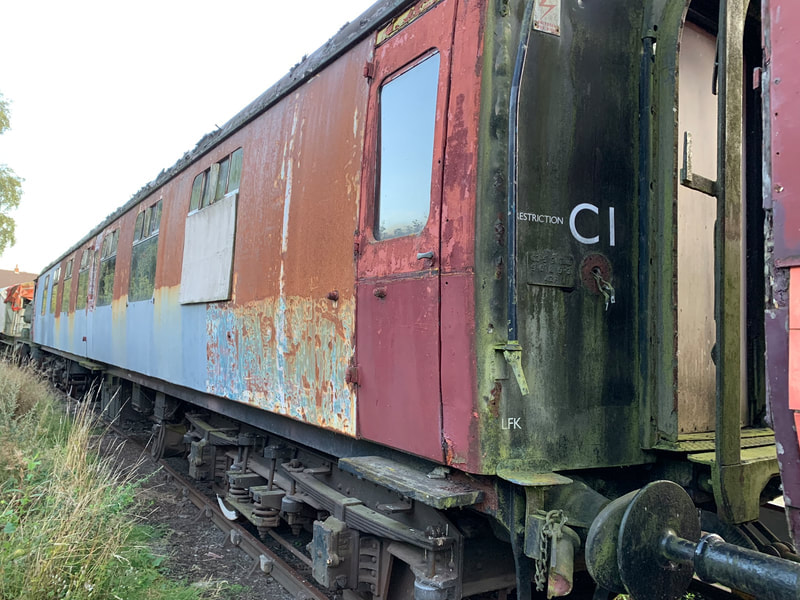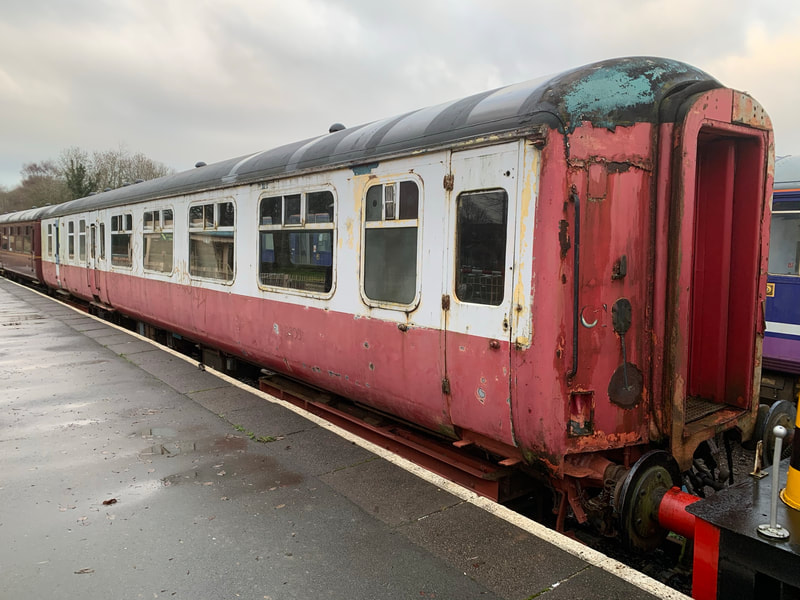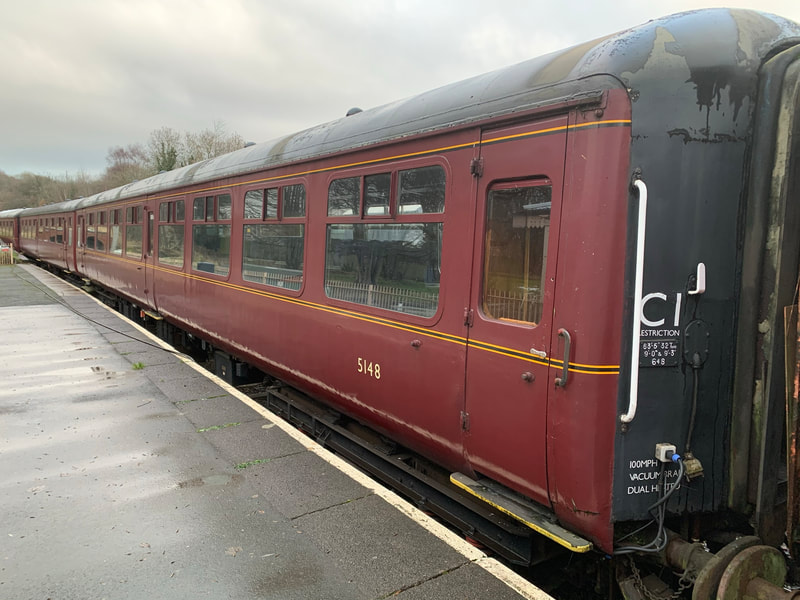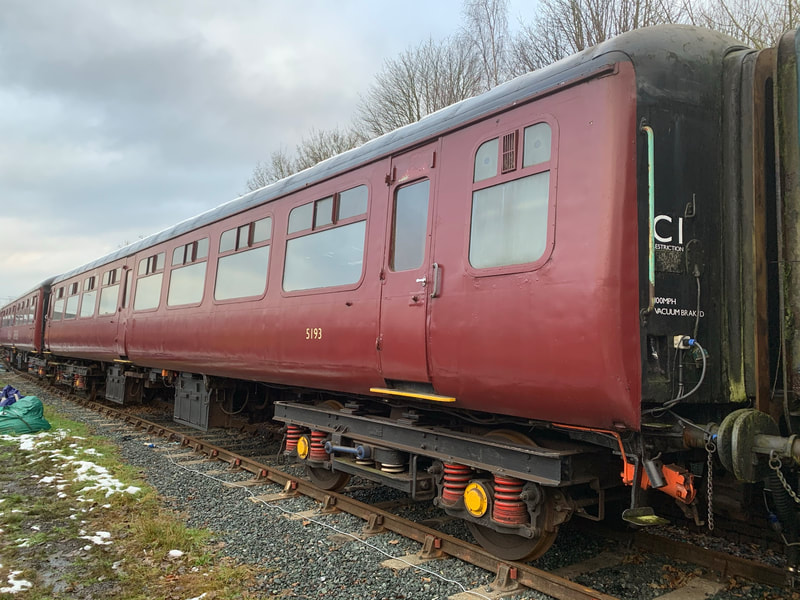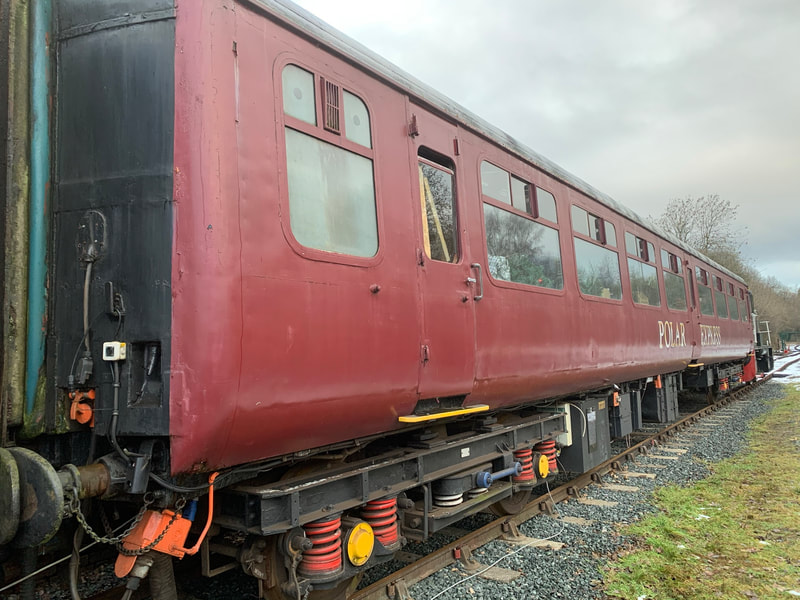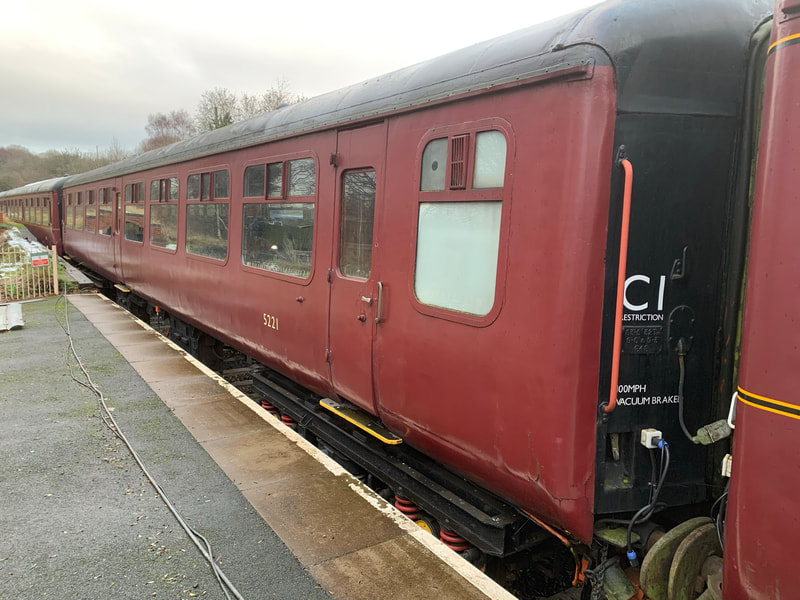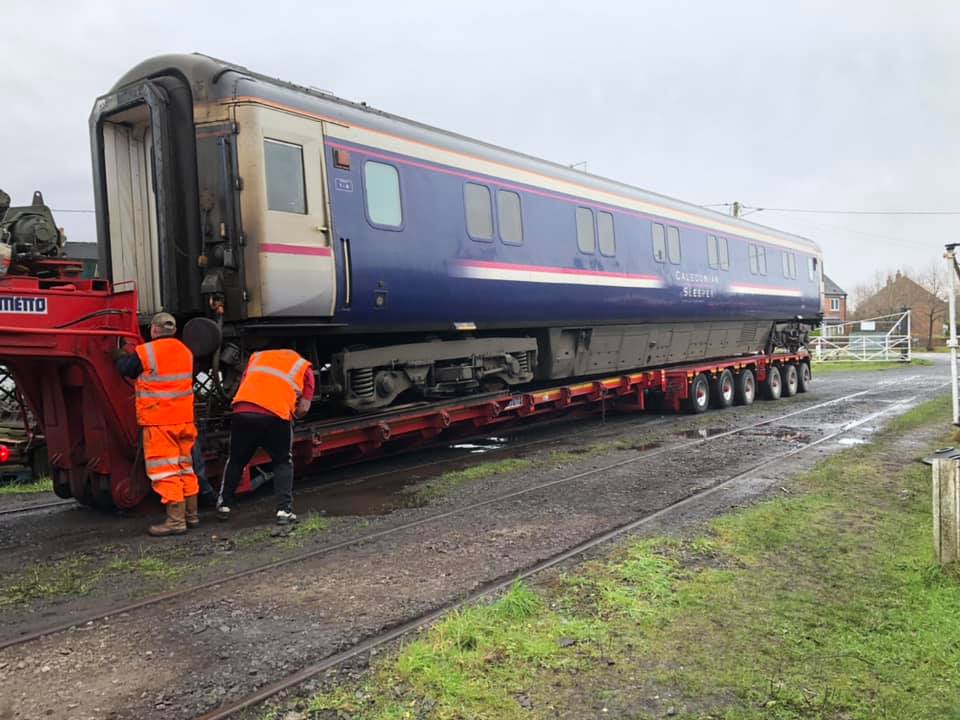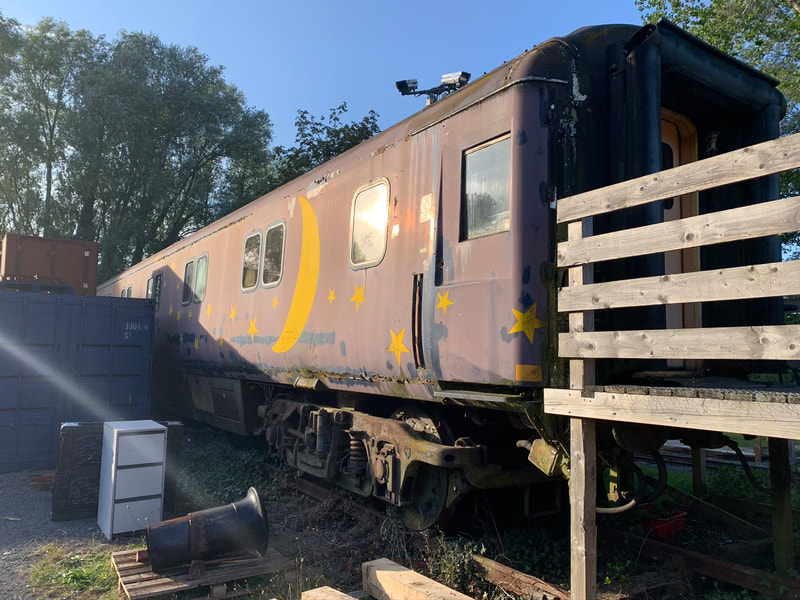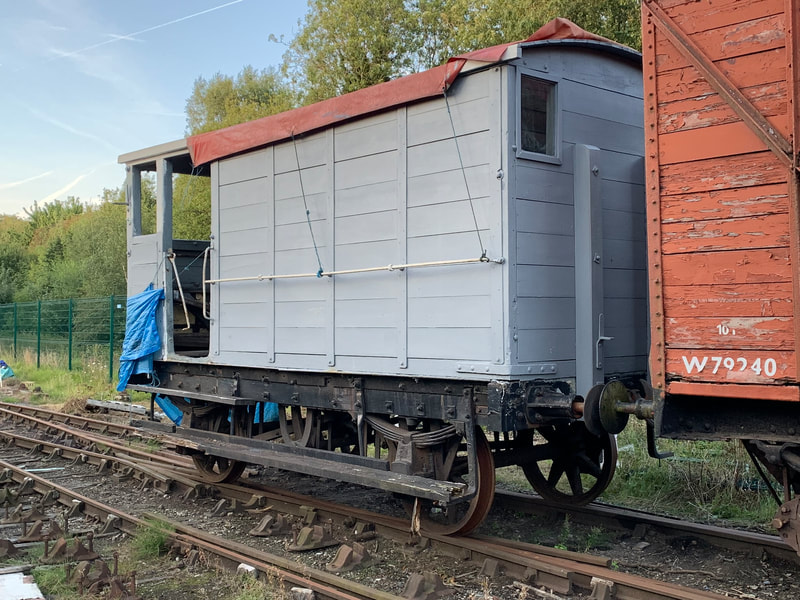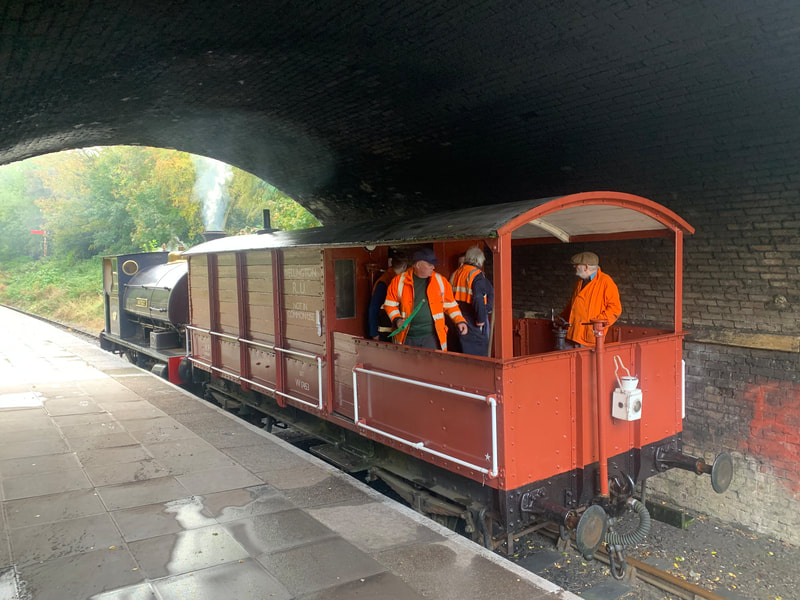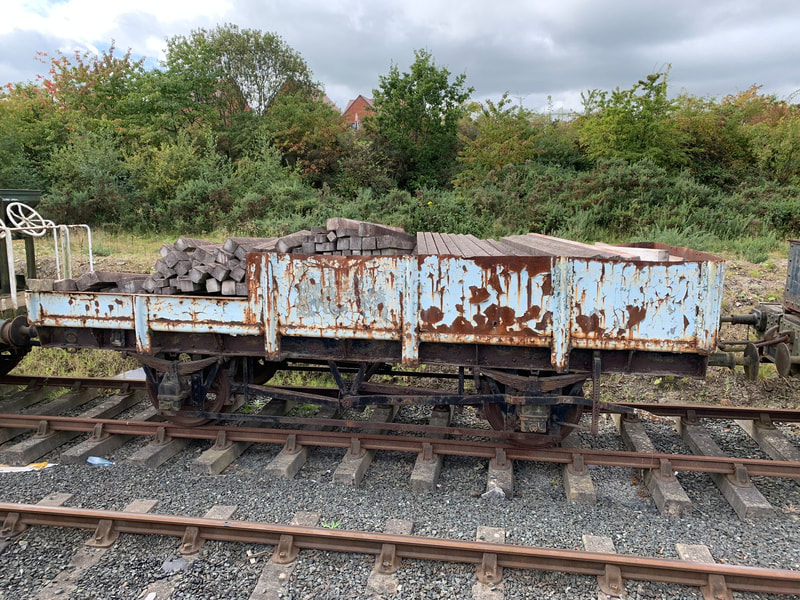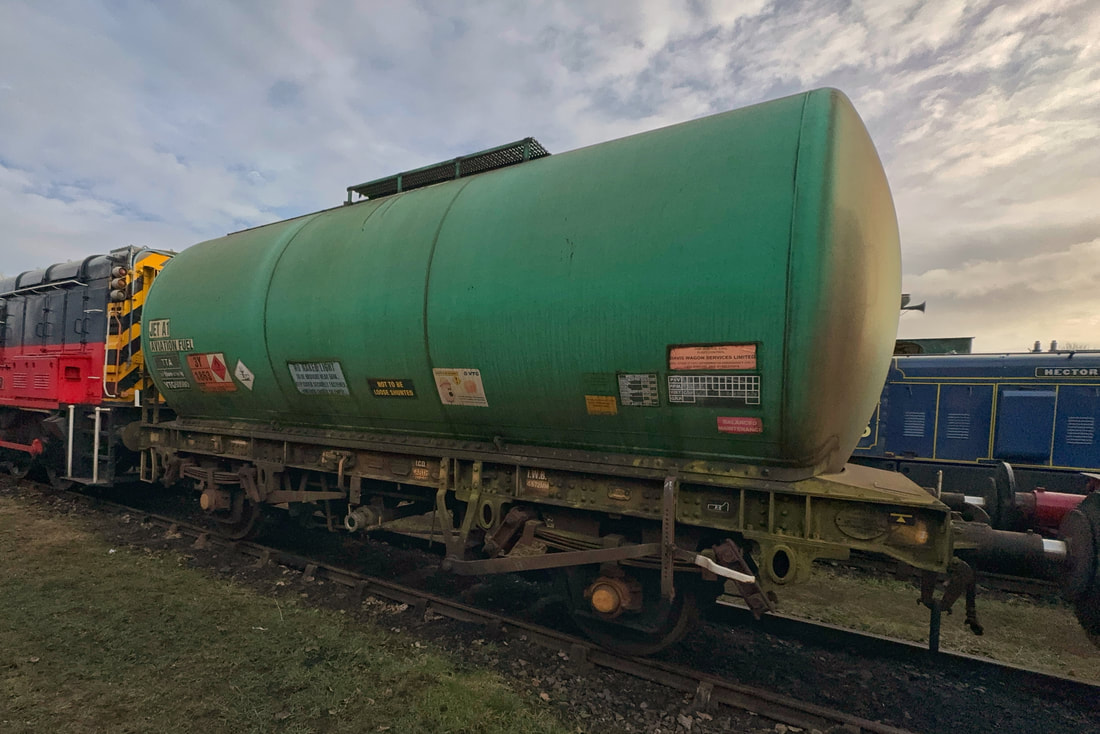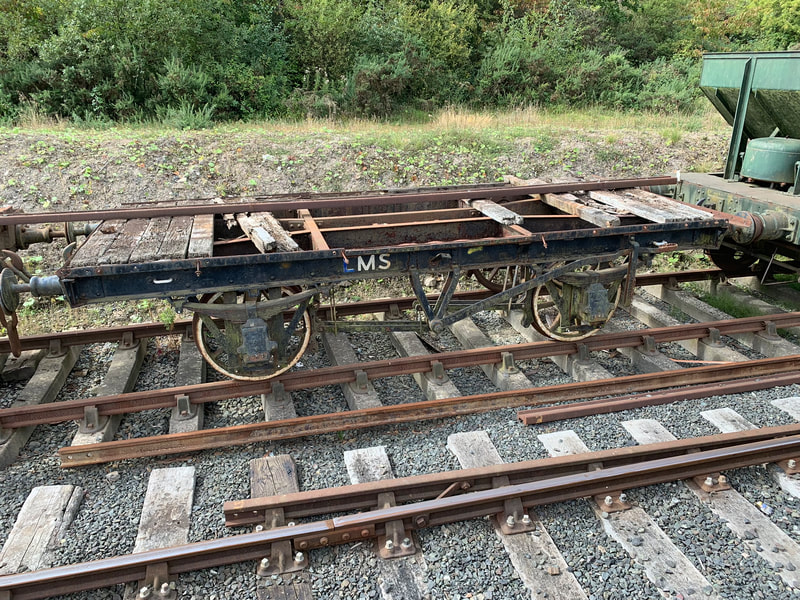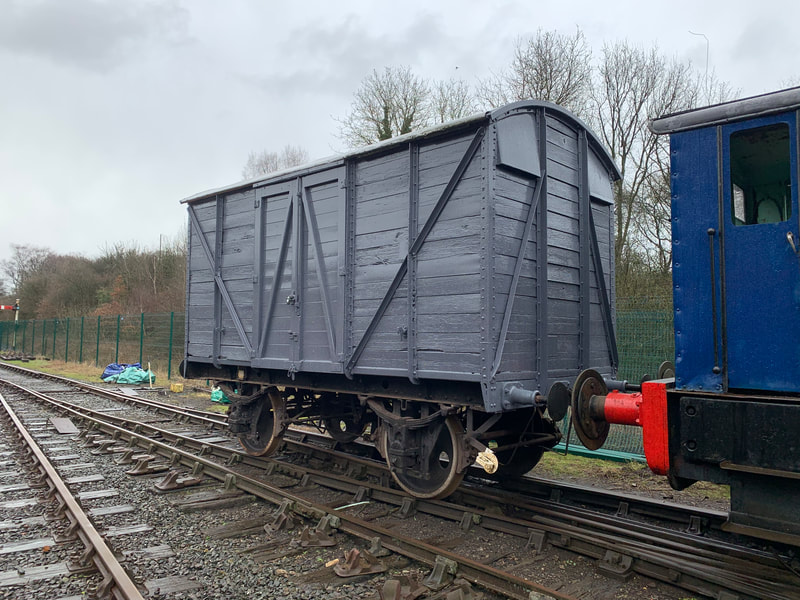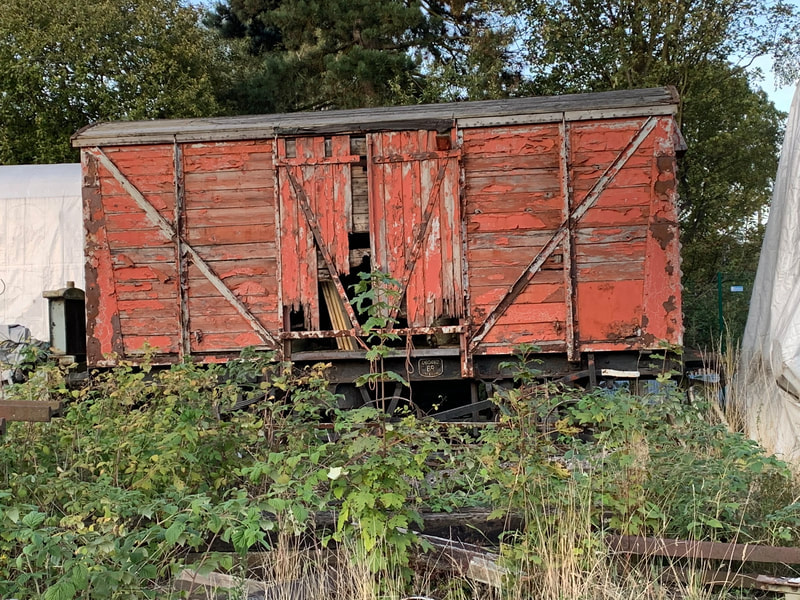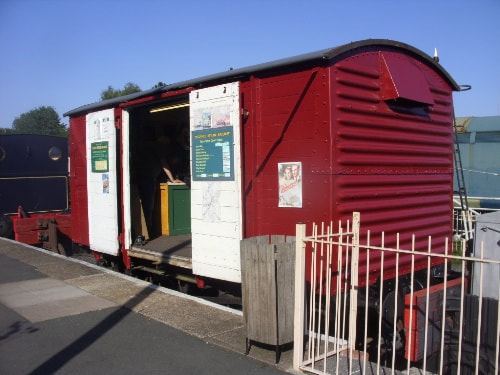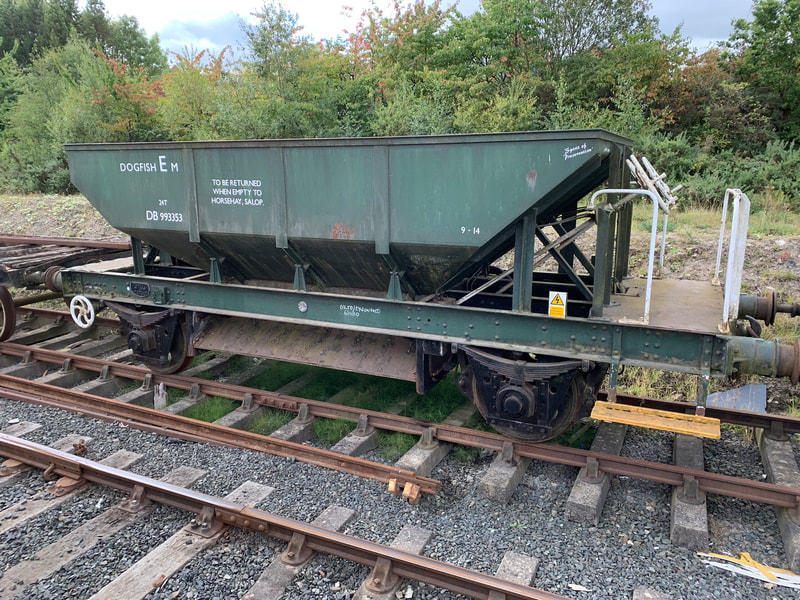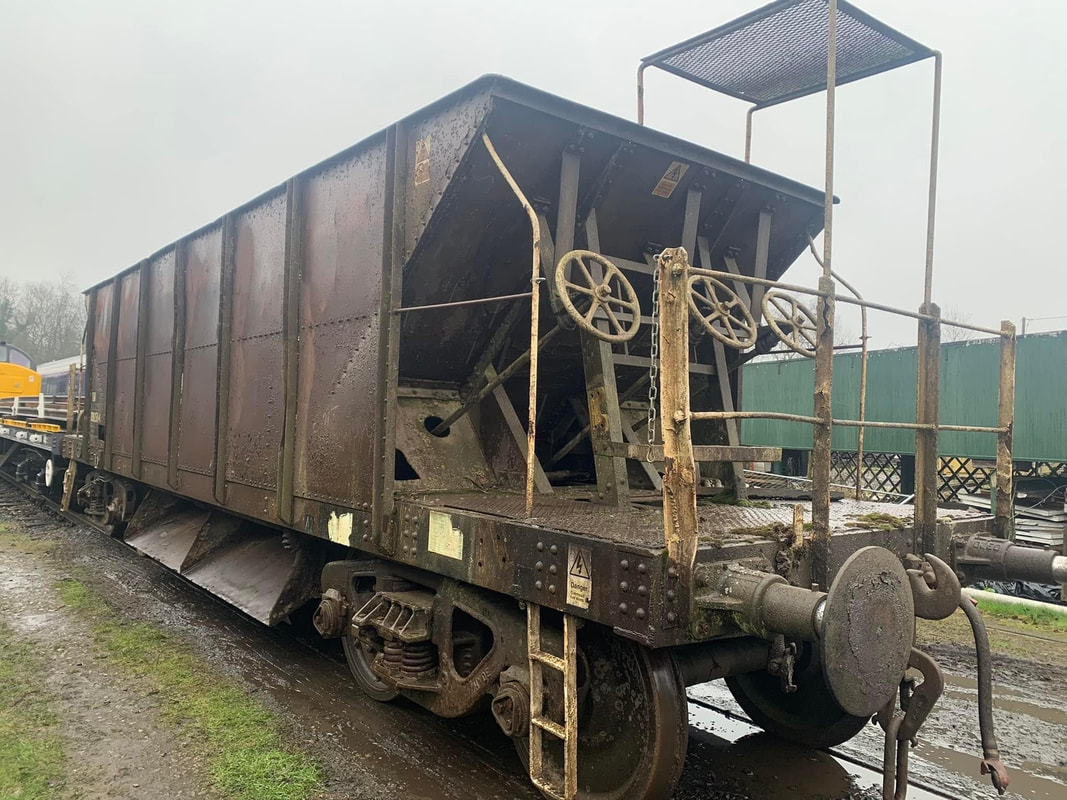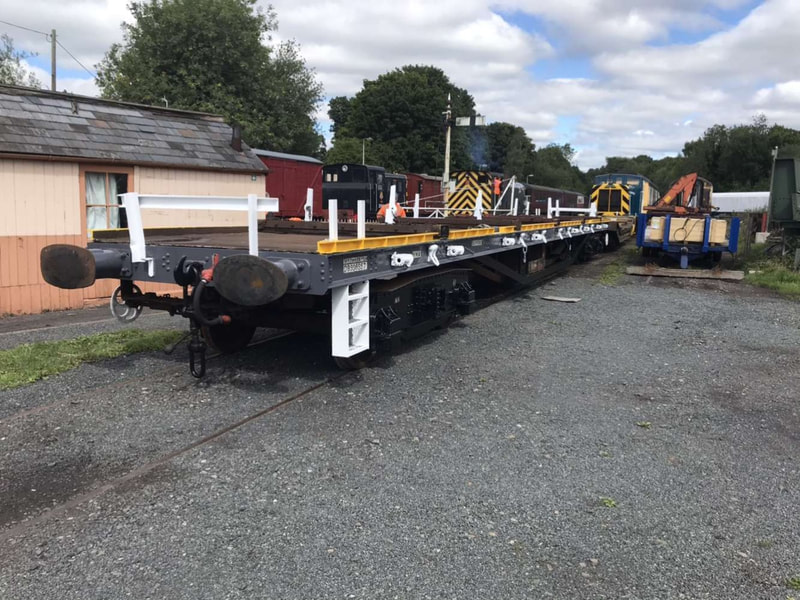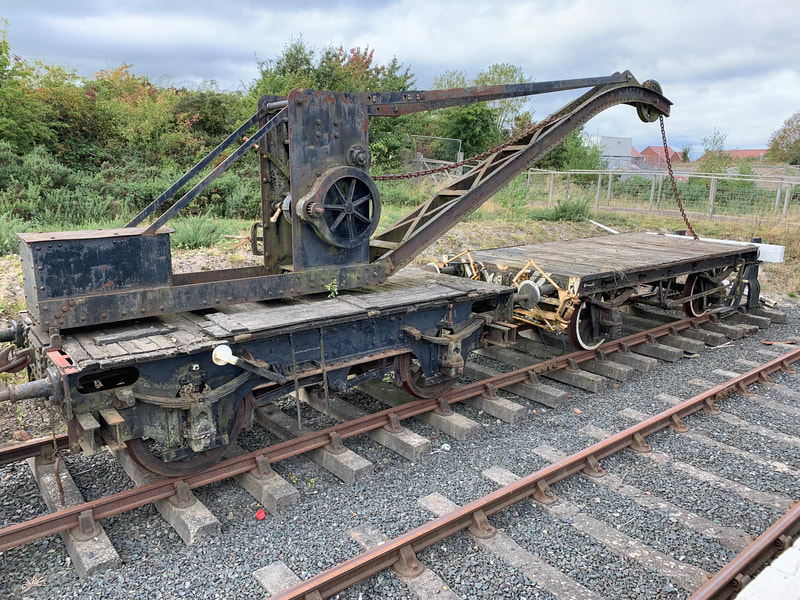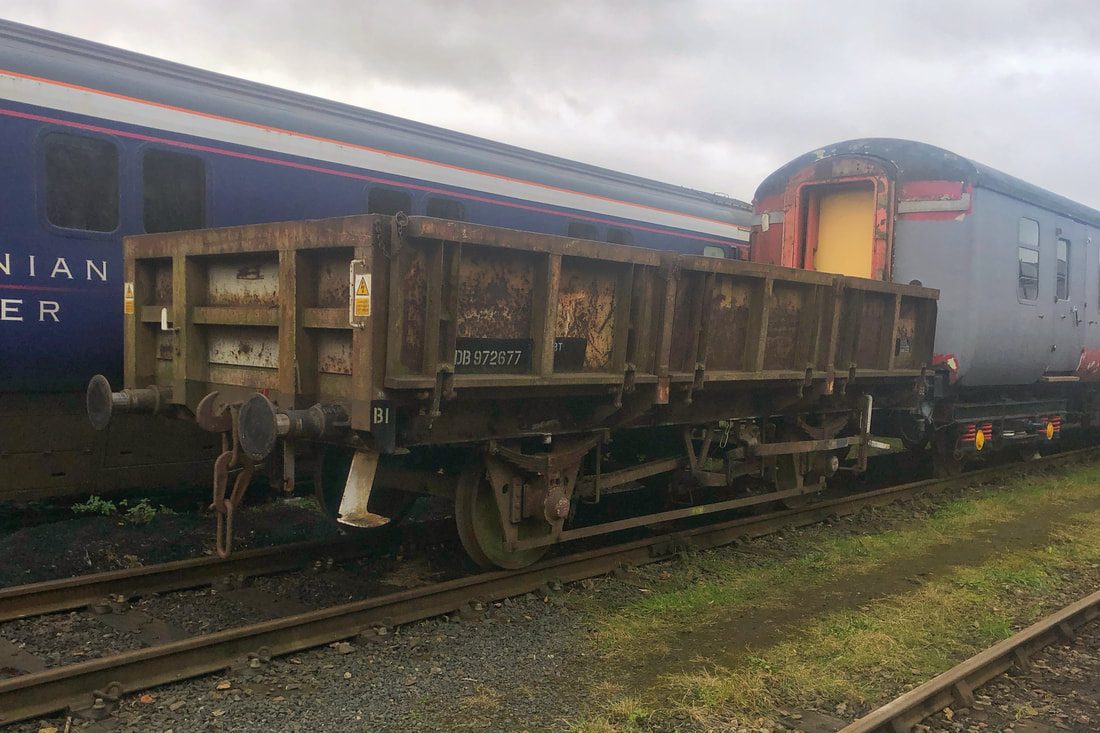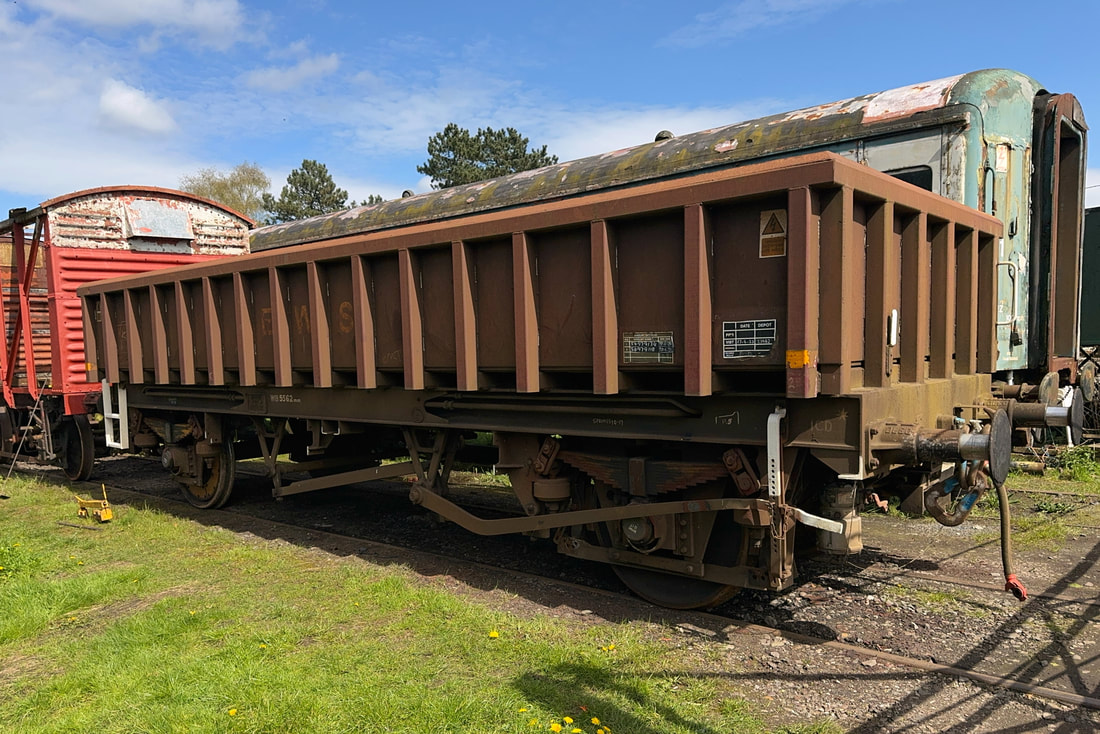STEAM LOCOMOTIVES
|
5619 hauling the POLAR EXPRESS trains at Telford
5619 at St Fagans South Wales - 1963
5619 at Telford Steam Railway in 2023
|
GWR - Class 56XX 0-6-2T No. 5619
-Lot No.228. Built March 1925. Weight = Empty 53T 12cwt, --Working 66T 16cwt
-Capacity 1900 Gallons. Cylinders 18in dia. * 26in stroke -Tractive Effort = 25,800 -Cost £3,988 including £906 for the boiler -Condemned 15 June 1964 -Sold to Woodham Bros. in Barry 18 August 1964 -Total Mileage at withdrawal = 778,263 5619 was designed by Charles Collett and built by the Great Western Railway at their Swindon Workshops in March 1925. She was designed to haul heavy coal trains and other freight in the South Wales valleys, but could also be seen hauling passenger trains as well. Shed allocations First - Chester, CHR 31 December 1947 - Abercynon, AYN August 1950 - Abercynon, 88E 1951 - Barry, 88C 1954 - Barry, 88C 1957 - Barry, 88C 1960 - Barry, 88C 1963 - Barry, 88C 5619 was withdrawn by British Railways in June 1964 and sold to Barry Scrap yard, which it entered in September 1964. After 8 years and 8 months 5619 left Barry scrap yard in May 1973, when she was bought by The Telford Development Corporation (TDC) for static display at Horsehay Goods shed. However, Telford Horsehay Steam Trust (Telford Steam Railway), which had been formed in 1976, convinced TDC to allow the trust to restore the locomotive to operational use, and it first steamed again in 1981. Since then 5619 has steamed on many heritage railways, including (in alphabetical order) Avon Valley Railway Bodmin & Wenford Railway Churnet Valley Railway Epping Ongar Railway Gloucester and Warwickshire Railway Llangollen Railway Midland Railway Centre Nene Valley Railway North Norfolk Railway Severn Valley Railway Swanage Railway Swindon & Crickdale Railway and others SERVICABLE. Currently running at Telford Steam Railway Owned by Telford Steam Railway |
|
"Rocket" at Courtaulds Ltd at Coventy - Circa 1966
'Rocket' on 21 January 2024 after her chimney, cab and water tank had been removed, ready for preperation to lift her boiler.
|
Peckett 0-4-0ST No. 1722
|
|
1990 at Ironbridge Power Station circa 1966
1990 at CEGB Ironbridge Power Station, January 1974
|
Peckett 0-4-0ST No. 1990
|
Sentinel 0-4-0VBT. No. 9366 Built in Shrewsbury by Sentinel in 1945, this steam locomotive has a vertical boiler and an all enclosed two cylinder vertical 100hp engine. All wheels are driven via chains through a two speed gearbox. The loco went new to Tottenham Gas and Light Company and was No 11 in their fleet.
CURRENTLY OUT ON HIRE at Chasewater Railway from 7 February 2024. Privately Owned |
2' Gauge 0-4-0 Steam TramConstructed by Alan Keef Limited around 1977, this locomotive is powered by a vertical boilered steam engine. It has a single cylinder and chain drive to both axles and was named "Thomas" (after Thomas Telford) by the Rev. W. Awdry on 9 April 1980.
The tram and coach originally ran at the Telford Town Park, but was brought to the Telford Steam Railway in the mid 1980s. The tram last ran in 2019, after which it was withdrawn due to its boiler being beyond economic repair. An appeal is currently open to raise funds to purchase a new boiler, and hopefully it will be back in operation soon. UNDER OVERHAUL Owned by Telford Steam Railway |
DIESEL LOCOMOTIVES
Class 08 No. 08757
|
Class 37 No. 37263
She was built by the English Electric Vulcan Foundry in 1965 for British Railways, carrying the Pre-tops number D6963, and was allocated to Darnall.
Originally allocated to many Eastern Region depots, the loco then moved to Scotland, before moving to Cardiff and then more locally to Toton and Bescot. Her last passenger train was worked in 1998 under Trainload Freight West, transferring to EWS ownership in 1998 where 37263 was stored in late 1999 before being withdrawn. Initially she went to the Dean Forest Railway but then moved to Tyseley Locomotive Works for a number of years before coming to Telford in 2017. The current owners have completed a thorough overhaul and restoration with the loco re entered revenue earning service at Telford in June 2021. CURRENTLY OUT ON HIRE at Severn Valley Railway Privately Owned |
British Rail Class 142 No. 142058142058 was the 26th Class 142 to be preserved. It was last stationed at Newton Heath (Manchester) under Northern Rail before preservation and movement to Telford Steam Railway in April 2021, joining recently preserved Class 144 144013 on the railway.
In August 2021, 142058 operated its first test runs along the railway, prior to entering passenger service. SERVICABLE Owned by Telford Steam Railway |
British Rail Class 142 No. 142004142004 was the 27th Class 142 to be preserved. )It was last stationed at Newton Heath (Manchester) under Northern Rail before preservation and movement to Telford Steam Railway in April 2021. 142004 was one of the first Class 142's known to be set aside for preservation, but the plans of its future were kept private for over a year and 142004 ended up being one of the last two Class 142 sets still standing on mainline depots, latterly stored at Heaton depot.
SERVICABLE Privately Owned |
British Rail Class 144 No. 144013
144013 became the fourth Class 144 to be preserved when it was moved over two days by road to Telford Steam Railway in July 2020. The set was bought to aid the railway's expansion aims in the future, to run off-peak services to Ironbridge
SERVICABLE Owned by Telford Steam Railway |
Ruston & Hornsby 0-4-0DH Class LSSH No. 525947
|
North British 0-4-0DH No. 27414
|
Ruston & Hornsby 0-4-0DM Class 165DS No. 313394
|
Ruston & Hornsby 0-4-0DM Class 88DS No. 382824
|
British Railways Class 03 diesel D2051/03051
|
Go to 5 min 56 sec of this lovely video to see D2051 in action in 1967
D2051 at Telford Steam Railway, November 2023.
|
D2051 was built by British Railways and entered service at Hull Dairycotes on 27 January 1959. It was withdrawn on 14 December 1972 from Colchester. It was sold to Ford Motor Company where it ran at Dagenham as No. 7 and later No.4. D2051 was bought for preservation in 1997, and moved to the North Norfolk Railway in 2000. In 2023 she was purchased by her current owner, and moved to Telford Steam Railway in November 2023. D2051 is now being restored. RESTORATION STARTED Privately Owned |
2FT Gauge Ruston 16-20 hp 4-WD No 229633
|
|
We are grateful to the owner for providing the locomotive's history
Extract from: THE NARROW GAUGE RAILWAY SOCIETY No. 52 - NOVEMBER 1969 (Ken Hartley) Thanks to to co-operation of the Army Dept. authorities, on October 12th 1968, a small party of N.G.R.S. (London Area) members had the privilege of being the "first ever" visitors to the "Decauville" line at Barlow N.C.O.S.D. near Selby (Yorkshire) ... [N.B. This may be a typo for N.C.R.S.D. (Naval Command Returned Stores Depot)] The loco in service, a cab-fitted "Ruston" 16 - 20 h.p. 4-WD (No229633/built 1944) was parked under a long lean-to shelter, on a train of six bogie wagons. Rather to the surprise of the visitors, the engine started straight away, "on the handle", and was then run up the line to the passing loop, where it was attached to a couple of spare wagons and, with the party entrained, then proceeded towards the engine shed and spare locos. By mid-1965, oil consumption of the (Hunslet) locos was getting rather heavy, and the wheel treads on "No. 1" very worn. Consequently on September 17th RUSTON No. 229633 (LOD 758141) arrived from Chilwell Depot, overhauled, repainted and fitted with a brand-new "full cab". Paul Evans, curator at the Internal Fire Museum of Power, near Cardigan, told me that this locomotive was part of a narrow gauge bundle including a couple of Hunslets that came to him from the Scapa Flow Museum. He passed the lot over to Hollycombe Steam Railway several years ago. He had originally envisaged setting up a narrow gauge railway at the museum but gave up on the idea. The following is an extract from a reply from Patrick Keef of Alan Keef Ltd to an enquiry ... "The locomotive in your pictures is indeed a Ruston & Hornsby 20DL machine. I believe that it is locomotive No. 229633 built in 1944 and supplied to the Ministry of Defence. It was latterly in Orkney where it was used for a proposed railway at Scapa Flow Visitor Centre. This project came to nothing and moved to a private collection in Surrey when I saw it three years ago. I believe that it has subsequently moved on from there. At the time I saw it, I believe that the engine was in poor condition, but a spare working unit was available, which you infer to still be the case. In terms of restoration, as an ex-MOD machine, it is likely to have been well maintained and most critically, the gearbox will be in fair order. The engine swap should be a relatively straight forward proposition". It is belived that the Ruston was sold on from Hollycombe to Mr Bailey at Telford Steam Railway several years ago. The present owner purchased the locomotive from Mr Bailey. RESTORATION NEARING COMPLETION Privately Owned |
COACHING STOCK
LNWR 6 - Wheel Coach No. 11433Built as a five compartment coach in 1890 as No. 433. Around 1900 it became a parcels coach as was renumbered 11433.
Between 1912 to 1915 it became a car transporter, No. 4167, for the carrying of cars in the days before long distance motorway driving. Around 1924, it's use was again changed, becoming a 'Pooley' van and renumbered M36954M. A 'Pooley' van is of a known weight, used for servicing and callibrating weighbridges and scales in railway yards. After entering preservation and residing at a couple of heritage railways, 11433 arrived at Telford Steam Railway in 2015. AWAITING LONG-TERM RESTORATION Privately Owned |
GWR Auto Trailer No.38Built in 1907 to diagram N as part of lot 1126, No 38 is known to have been used on the Cholsey and Wallingford branch in 1933, and then later as a drawing office at Cardiff Canton. It was purchased by Telford Steam Railway whilst is was located at the Midland Railway Trust in July 1977. It was transported by rail to Wellington Goods yard in August 1977 where Class 25 diesel 25274 brought it up from Lightmoor to Horsehay and therefore has the distinction of being the last passenger vehicle to travel the line before it was lifted by British Rail.
AWAITING LONG-TERM RESTORATION Owned by Telford Steam Railway |
SC14901 awaiting restorationCarriage diagram.
Photo from the R W Carroll collection taken on 4 August 1976, showing SC14901 at Inverness in a Motorail train.
Photo taken by Hugh Searle on 2 April 1977, showing SC14901 at Aberdeen.
Photo from the Eastbank Model Railway website showing SC14901 at Turkey Yard, Springburn, Glasgow in April 1978.
Photo taken by John Carter on 29 June 1980, of SC14901 at Cowlairs, Glasgow.
Photo taken by demu1037 on 28 May 2007, of the lounge after SC14901 had been restored by Telford Steam Railway volunteers.
Photo taken by Chris Bell on 1 August 2010, showing SC14901 in maroon livery at Spring Village.
This undated photograph, taken by Mike Joy, shows SC14901 at Telford Steam Railway in the process of being repainted into BR Crimson and Cream livery. It was during this repaint that the coach was vandalised.
Part of the lounge car in 2024, awaiting restoration after vandalism
Builders plate.
|
BR MK1 1st Class Lounge Car No. SC14901 - a UNIQUE survivor! SC14901 was one of three MK1 coaches converted into lounge cars. The original idea was to gauge public reaction to see if there was scope for a supplement-paying 'luxury class'.
Extract from Modern Railway magazine June 1967. (Thanks to Mike Joy for providing the information). BRITISH RAIL’s first lounge car prototype made its belated debut in late April, offered simply as a new form of first-class accommodation without any supplemental fare. In the three converted BR standard compartment firsts, four of the orthodox compartments have been taken out and replaced by two 10-seater lounges. The vehicles’ existing Commonwealth bogies have been retained, keeping the cost of the modifications (carried out at Eastleigh works) down to £5000 per car. The first vehicle went into service on the WR from April 24. It has been incorporated in the XP64 train-set covering the 8:20 Swansea –Paddington and 19:00 back, and the 12:45 Paddington – Bristol and 16:15 back. The other two cars are to work on the King’s Cross – West Riding and Glasgow – Lancashire routes, but the specific services have yet to be settled. BRB researchers are to travel on the cars and sample users’ opinion on the lounge concept. The opinions they collect will help formulate BR policy on whether to include new lounge cars in the annual output of some 250 new main-line coaches which has been authorised over the next few years. One view is that lounge cars are successors to Pullmans, which are to be gradually phased out of BR services. Pullman – type windows Rich wood panelling, extensive areas of glass and contrasting dark and pastel shades of cloth are the dominant features of décor in the lounges. The corridor bodyside panelling in the area of the lounge compartments has been replaced with veneered Afrormosia to match that inside the lounge, where it has been applied to the bodyside and one transverse partition; the other has been covered with veneered Bombay Rosewood. Each lounge compartment bodyside has been refitted with two 5ft double-glazed windows, similar to those used on the new Pullmans. Each encloses a pair of venetian blinds within the double glazing and each blind, covering half a window, is operated independently by a handle located close to each bodyside seat. Between the windows is a mirror just over 1½ft wide. A 5ft grille luggage rack mounted above the mirror has specially rounded corners. A litter bin, recessed into the bodyside below each window, is press-button operated. The front of the bin is covered by an Afrormosia veneered panel so that it is inconspicuous when closed out of use. Steam heating retained. The existing arrangement of steam heating has been retained. Standard Westinghouse tubular heaters, as used in BR open saloons, have been fitted at the base of the bodysides in each of the lounge compartments in place of the original compartment underseat heaters. Deflector plates have been fitted behind each tubular heater and support the shaped top cover, made of solid Afrormosia. The heater front covers are made of steel with slotted recesses at top and bottom, so that air entering at floor level will pass over the tubular heaters and be deflected outwards into the lounge compartments through the top slots, concealed below the casing of the Afrormosia top cover. The heater front covers have been nylon-coated in the same dark grey colour as the luggage racks. Similar tubular heaters have been fitted at the base of the corridor partitions, with the same arrangement of deflectors and top and front covers. The heat regulator control is mounted on each corner bodyside quarter panel between the window and the transverse partition, alongside the corner venetian blind operating handle; both of these can be operated by the passenger occupying the corner seat without getting up. Each regulator controls half the heaters in each lounge compartment. The corridor doors and partitions are almost completely glazed in anodised aluminium frames, with multi-ply panels above and below the glass. The latter has been covered with dark blue, pimple-grained Acrowalk Lionide down to the top of the solid Afroromosia heater cover; on the corridor side they are similarly covered down to the stainless steel kicking strips, which have louvres to allow air from the corridor to enter the lounge through cut outs in the multi-ply panels (the air is warmed as it passes over the tubular heaters). Each lounge has two corridor sliding doors. Specially designed, fixed seat units with steel frames have been built against both transverse partitions in the lounge compartments. The seat ends are independent of both bodyside and corridor partition and are shaped to provide a cased-in armrest. Each of the two intermediate armrests has a pull-out ashtray inserted in the nose ends. Each seat has an adjustable head-rest pillow, retained in location by straps. Swivel seats The four swivel seats are similar in design to the fixed seat units. They are firmly secured to the floor, but in places that afford the maximum range of rotation movement within the space available. A novel feature is the newspaper-magazine shelf recessed in the base of each seat. The seating, apart from the cushions and the armrests and bases on the fixed seats, has been trimmed with black Colorado grained Lionide on knitted cloth. One armrest of each swivel seat is fitted with a pull-out ashtray and the other has a switch wired through the pedestal of the swivel seat to an individual reading light with a high-intensity spotlight beam, mounted on the ceiling immediately above it. Similar individual reading lights have been embodied in the underside of the solid-base luggage racks above the fixed seats. Varied colour schemes Each of the three prototypes has a different colour scheme for the seat cushions and backs of the fixed seats and the seat cushions of the swivel chairs. In one the colour scheme is olive green, in another red and blue and in the third mustard and brown. The head covers are of two different materials; in the first and third schemes the trim is in maize fabric and the second orange fabric. There are full-length curtains to the corridor partition, single width at the ends of each compartment and double width in the middle. In the mock-up displayed in 1964, the curtains were mechanically operated, but this gadgetry has been discarded in the prototype. The curtains for each prototype vehicle are again of different materials: those for the first scheme are blue-and-green striped, those for the second silver-and-grey striped and those for the third apricot-and-gold striped. The floors are carpeted; colours are light greenfinch-and-lemon olive in the first and third schemes and grey-and-blue in the second. A small hinged shelf of Afrormosia with a stainless steel edging is recessed into the bodyside below each window. These shelves are poorly conceived. They are easily caught and knocked up if one raises a knee and need some catch to hold them firmly open as well a one to retain them closed out of use. Fluorescent lighting The underside of the flooring is insulated with glass fibre, retained in position by corrugated aluminium sheets. The bodysides which have increased in thickness to approximately 3in to accommodate the double-glazed windows and to house the recessed litter bins and hinged shelves, are also fully insulated with glass fibre which has also been used for the insulation of the roof. The ceilings of the lounge compartments have been specially designed to suit fluorescent lighting, which is additional to the individual reading lamps over each seat. The ceiling panels which carry the reading lamps over the swivel chairs have been made almost flat and join the corridor partition approximately 2½ in above the top of the curtain pelmet. Three 4ft 40 watt fluorescent tubes are ceiling mounted longitudinally above the curtain rails and adjacent to the head of the corridor partition; the latter is glazed with removable reeded perspex panels opposite each tube so that the light shines into the corridor, as well as into the lounge, over the top of the curtain pelmet. Reflectors have been secured to the underside of the corridor ceiling between the tubes and the perspex panels, to diffuse and direct the light downwards into the corridor. There are three more 4ft 40 watt fluorescent tubes on the bodyside of the lounge. The bodyside panelling has been curved sharply inwards to enclose these tubes in a kind of clerestory, again with reeded perspex panels to diffuse the light. The light fittings and bulk inverters, which supply the power for the fluorescent lighting by converting the 24/32V d.c. supply to 220V at 500c/sand have a maximum output of 1,000 watts, have been supplied by J. Stone & Co. Principal contractors and suppliers 5ft bodyside windows and corridor sliding door runner gear: Beckett, Laycock & Watkinson Ltd. Venetian blinds: Airelite Venetian Blind Co. Ltd. Toughened glass and mirrors: Pilkington Bros. Aluminium luggage rack brackets: Bardic Ltd. Tubular steam heaters; Westinghouse Brake & Signal Co. Aluminium sections: British Aluminium Co. Aluminium castings: Bardic Ltd. Electric light equipment: reeded perspex panels: J. Stone & Co Ltd. Electric light recessed rocker switches: Britmac Electrics Ltd.` When first introduced into traffic, it is believed that 14900 went to the North East region, 14901 to the Western Region and 14902 to the Midland region. When new 14902 was used on the Nottinghman - St Pancras business trains. All three coaches eventiually migrated to Scotland to work the Stirling to Inverness Motorail which was introduced in the mid seventies. SK14902 was withdrawn in 1974 and SK14900 in 1978. Both were subsequently scrapped. SK14901 survived in service until 1981. It went to the Severn Valley Railway where the Commonwealth bogies were replaced with the bogies that the carriage sits on today. SK14901 arrived at Telford Steam Railway between 1982 and 1986 and after restoration, was the mainstay of our loco hauled stock for anumber of years. Unfortunately the coach has since suffered damage from repeated vandalism, with most of the windows being broken. AWAITING LONG-TERM RESTORATION Owned by Telford Steam Railway |
BR Mk2 BSO No. 9406Mk 2. Later modified with mini buffet as 9106. Became internal user at Preston as 024909. Sold 1994 from BR to Transrail, then to EWS, then DBS. After many years at Preston moved to Crewe Diesel Depot 1/10, then to Ruddington, Great Central (Northern), by 04/12. Then to Mid Norfolk 03/12. Advertised for sale by 09/12 and by 01/17 moved to Telford Steam Railway.
9406 is in the process of being converted to be our accessible coach, for more information click here UNDER RESTORATION Owned by Telford Steam Railway |
BR MK2 TSO No. 5148Tourist Second Open or Tourist Standard Open, abbreviated to TSO, is a type of British Railways coach. The designation Tourist was originally as opposed to a normal SO (Second Open) coach. Both types have the same number of seating bays per coach, but the TSO has four seats across, arranged 2+2 either side of a central
aisle, while an SO has 3 seats across, arranged 2+1 with an offset aisle. Both offer the same legroom, but there is slightly less width per passenger in a TSO. The Mark 2 TSO was a direct development of the Mark 1 version and the early Mark 2 TSOs (of which this coach is an example) had an almost identical layout, including the pair of toilets either side of the gangway at one end and the two identical four-bay saloons separated by a just-off-mid-coach transverse vestibule, with further transverse vestibules at the outer end of each saloon. Later MK2 design saw the centre vestibule abolished, although the mid-coach divider was retained to still give two saloons of four bays each. The space saved by the abolition of the centre vestibule was used to re-locate the toilets, with one now placed at each end, with the entrance vestibules beyond them. This enabled the fitting of wide wrap-round end doors in place of the traditional narrow ones. In 1987, British Rail changed the title to Tourist Standard Open, when Second Class Standard Class across the network. Usage Mark 2 coaches gradually replaced Mark 1s on crack express services, allowing the older vehicles to cascade down to secondary services and thus enable the steady withdrawal of pre-nationalisation designs. Early Mark 2s were then in turn cascaded as later designs took over top-link workings. Our example was built in British Rail workshops in 1964 with pressure ventilation and wood panelling. Fitted with vacuum brakes, so they could run with Mark 1 stock and supplied dual heating (steam & electric). In 2016, 5148 was hired from from the Mid Norfolk Railway and with two other hired in MK2's, formed the carriage set for that years Polar Express TM. Whilst the other two MK2's were returned, 5148 was purchsed by Telford Steam Railway and has remained at the railway ever since. In 2018, 5148 had a major overhaul with new flooring, new internal wooden panelling and new plumbing. One of then toilet areas was removed to allow storage of the technical equipment needed when running the Polar Express TM. It also received a full external repaint into maroon with yellow lining. 5148 is used for our Polar Express TM trains, and service trains when required SERVICABLE Owned by Telford Steam Railway |
BR Mk2 TSO No. 5193Tourist Second Open or Tourist Standard Open, abbreviated to TSO, is a type of British Railways coach. The designation Tourist was originally as opposed to a normal SO (Second Open) coach. Both types have the same number of seating bays per coach, but the TSO has four seats across, arranged 2+2 either side of a central
aisle, while an SO has 3 seats across, arranged 2+1 with an offset aisle. Both offer the same legroom, but there is slightly less width per passenger in a TSO. The Mark 2 TSO was a direct development of the Mark 1 version and the early Mark 2 TSOs (of which this coach is an example) had an almost identical layout, including the pair of toilets either side of the gangway at one end and the two identical four-bay saloons separated by a just-off-mid-coach transverse vestibule, with further transverse vestibules at the outer end of each saloon. Later MK2 design saw the centre vestibule abolished, although the mid-coach divider was retained to still give two saloons of four bays each. The space saved by the abolition of the centre vestibule was used to re-locate the toilets, with one now placed at each end, with the entrance vestibules beyond them. This enabled the fitting of wide wrap-round end doors in place of the traditional narrow ones. In 1987, British Rail changed the title to Tourist Standard Open, when Second Class Standard Class across the network. Usage Mark 2 coaches gradually replaced Mark 1s on crack express services, allowing the older vehicles to cascade down to secondary services and thus enable the steady withdrawal of pre-nationalisation designs. Early Mark 2s were then in turn cascaded as later designs took over top-link workings. Our example was built in British Rail workshops in 1964 with pressure ventilation and wood panelling. Fitted with vacuum brakes, so they could run with Mark 1 stock and supplied dual heating (steam & electric). 5193 arrived at Telford Steam Railway in 2017 from Tyseley. That year it was overhauled recieving new interior wood panelling and external repaint into maroon livery. 5193 is used for our Polar Express TM trains, and service trains when required SERVICABLE Owned by Telford Steam Railway |
BR MK2 TSO No. 5220Tourist Second Open or Tourist Standard Open, abbreviated to TSO, is a type of British Railways coach. The designation Tourist was originally as opposed to a normal SO (Second Open) coach. Both types have the same number of seating bays per coach, but the TSO has four seats across, arranged 2+2 either side of a central
aisle, while an SO has 3 seats across, arranged 2+1 with an offset aisle. Both offer the same legroom, but there is slightly less width per passenger in a TSO. The Mark 2 TSO was a direct development of the Mark 1 version and the early Mark 2 TSOs (of which this coach is an example) had an almost identical layout, including the pair of toilets either side of the gangway at one end and the two identical four-bay saloons separated by a just-off-mid-coach transverse vestibule, with further transverse vestibules at the outer end of each saloon. Later MK2 design saw the centre vestibule abolished, although the mid-coach divider was retained to still give two saloons of four bays each. The space saved by the abolition of the centre vestibule was used to re-locate the toilets, with one now placed at each end, with the entrance vestibules beyond them. This enabled the fitting of wide wrap-round end doors in place of the traditional narrow ones. In 1987, British Rail changed the title to Tourist Standard Open, when Second Class Standard Class across the network. Usage Mark 2 coaches gradually replaced Mark 1s on crack express services, allowing the older vehicles to cascade down to secondary services and thus enable the steady withdrawal of pre-nationalisation designs. Early Mark 2s were then in turn cascaded as later designs took over top-link workings. Our example was built in British Rail workshops in 1964 with pressure ventilation and wood panelling. Fitted with vacuum brakes, so they could run with Mark 1 stock and supplied dual heating (steam & electric). 5220 arrived at Telford Steam Railway in 2017 from the Kent and East Sussex Railway. That year it was overhauled recieving new interior wood panelling and external repaint into maroon livery. 5220 is used for our Polar Express TM trains, and service trains when required SERVICABLE Owned by Telford Steam Railway |
BR MK2 TSO No. 5221Tourist Second Open or Tourist Standard Open, abbreviated to TSO, is a type of British Railways coach. The designation Tourist was originally as opposed to a normal SO (Second Open) coach. Both types have the same number of seating bays per coach, but the TSO has four seats across, arranged 2+2 either side of a central
aisle, while an SO has 3 seats across, arranged 2+1 with an offset aisle. Both offer the same legroom, but there is slightly less width per passenger in a TSO. The Mark 2 TSO was a direct development of the Mark 1 version and the early Mark 2 TSOs (of which this coach is an example) had an almost identical layout, including the pair of toilets either side of the gangway at one end and the two identical four-bay saloons separated by a just-off-mid-coach transverse vestibule, with further transverse vestibules at the outer end of each saloon. Later MK2 design saw the centre vestibule abolished, although the mid-coach divider was retained to still give two saloons of four bays each. The space saved by the abolition of the centre vestibule was used to re-locate the toilets, with one now placed at each end, with the entrance vestibules beyond them. This enabled the fitting of wide wrap-round end doors in place of the traditional narrow ones. In 1987, British Rail changed the title to Tourist Standard Open, when Second Class Standard Class across the network. Usage Mark 2 coaches gradually replaced Mark 1s on crack express services, allowing the older vehicles to cascade down to secondary services and thus enable the steady withdrawal of pre-nationalisation designs. Early Mark 2s were then in turn cascaded as later designs took over top-link workings. Our example was built in British Rail workshops in 1964 with pressure ventilation and wood panelling. Fitted with vacuum brakes, so they could run with Mark 1 stock and supplied dual heating (steam & electric). 5221 arrived at Telford Steam Railway in 2017 from Tyseley. That year it was overhauled recieving new interior wood panelling and external repaint into maroon livery. 5221 is used for our Polar Express TM trains, and service trains when required SERVICABLE Owned by Telford Steam Railway |
BR Mk3a SLEP No. 10543A Sleeper Either class with Pantry (SLEP) is a type of railway sleeper car. A total of 208 vehicles were built at Derby Litchurch Lane Works by British Rail Engineering Limited between 1982–1984 to the British Rail Mark 3A profile for British Rail. They were introduced to replace an ageing fleet of Mark 1 sleeper cars built to various designs and which dated from the late 1950s to early 1960s. The order consisted of 88 SLE variants, constructed with thirteen bedrooms each, and 120 SLEP variants constructed with twelve bedrooms with the last compartment used for an attendant. The Mark 3 air-conditioned sleeping cars were introduced including many additional safety features that had been lacking in the Mark 1 carriages that had caught fire at Taunton. The Night Riviera stock was the first on the route fitted with controlled emission toilets.
SERVICABLE Owned by Telford Steam Railway |
WAGONS
Cannock & Rugeley Collery Brake Van No. 2This brakevan was Cannock & Rugeley Collery No.2 and later had been used at Granville Colliery, Donnington, Telford before coming to Telford Steam Railway.
When returned to service, it will be used on engineering, and demonstration goods trains. Any information about its history is very welcome. UNDER RESTORATION Privately Owned |
GWR 20t Brake Van 'Toad' No.17453Built in 1940, brakevans of this style were coded "TOAD" by the Great Western Railway and were used extensively throughout their system. Evidence shows that on steeply graded lines (Such as at Telford Steam Railway), it was common for a "TOAD" brakevan to be marshalled at either end of loose-coupled freight trains to provide addition braking for the heavy load.
Our example was bought for Telford Steam Railway directly from British Rail at Wimbledon, London and transferred by rail to Wellington Station and then by road to Horsehay. SERVICABLE Owned by Telford Steam Railway |
LNER 20t Brake VanBelieved to have been built at Darlington in 1937. This design became the basis for the standard BR brake van. It has come to Telford from the Colne Valley Railway.
Any additional information about this brakevan would be gratefully received. Arrived at Telford Steam Railway 23 July 2024 UNDER RESTORATION Privately Owned |
TTA - A Kerosene Tank Wagon No. 60580The TTA wagon was developed in the 1960s and continued in production into the 1970s. The wagons were originally built to haul petrochemical products across the country. Many wagons were repurposed later in life to carry a variety of other products.
Our example has arrived from Gascoigne Wood and we believe it was the last one to be preserved. Is a very useful addition to the railway and will be used as a water tank at Spring Village station during our POLAR EXPRESS TM trains, allowing the steam engine to take on water quicky and efficiently during each days services. It will also be availble to form part of our demonstration freight trains if required. SERVICABLE. Arrived at Telford Steam Railway on 16 January 2024. Owned by Telford Steam Railway |
Metro Cammel 24t Dogfish No. DB993353In all, 1249 wagons were built and were abundant on all Regions. SR & LMR stock had 'flared' chutes to allow the ballast to fall clear of the outside 3rd rail. Another variant was for carrying slag ballast, having 9" plates welded to the top edges of the hopper, e.g. DB993160/192/239. Dogfish were worked with other types of hoppers, a train of about 8 Dogfish and 4 Sealion wagons being common. On the Southern Region, some Dogfish were worked with Mermaid side-tippers, and lettered 'MER-DOG'. Surviving Dogfish received the "new" liveries such as Loadhaul and Departmental grey, then EWS maroon.
SERVICABLE Owned by Telford Steam Railway |
Metro-Cammell YGH Sealion Ballast Hopper No. DB982584Featuring a large hopper with slab sides, each with 7 vertical ribs, the type had three discharge chutes, one to the outside of each rail and one in the centre. At each end of the wagon was a control platform with three large handwheels to control each of the chute doors, with the YGH Versions being dual-braked to allow for operational flexibility
SERVICABLE Owned by Telford Steam Railway |
Salmon WagonThe 'Salmon' bogie rail wagon was based on an LMS design and was a 62ft long flat wagon fitted with 5 bolsters. A single wagon could carry a number of 60ft lengths of rail. A total of 894 wagons was built between 1949 and 1961 under 15 separate lots. Builders included private firms such as Head Wrightson Ltd and G R Turner as well as BR workshops at Derby and Wolverton and the 6 different diagram numbers issued reflected minor differences such as the inclusion or omission of a curb-rail. The wagons were built either unfitted or with a vacuum through pipe and in 1974 these were coded YMO and YMP respectively, with design codes in the YM500x, YM501x and YM502x series. By this time, many of the Salmon had had their bolsters removed to enable the carriage of 60ft track panels.
SERVICABLE Owned by Telford Steam Railway |
GWR 4w Manual Hand Crane No.792This hand operated crane is of Great Western Railway origin and was purchased by Telford Steam Railway in the early 1980's from Bleanau Ffestiniog. It was transported by road to Telford. It has previously been used to support track laying operations at the railway but now needs further restoration and overhaul.
AWAITING LONG-TERM RESTORATION Owned by Telford Steam Railway |
RUDD Ballast Wagon DB972677This wagon was originally built by British Railways at Shildon in 1958. It was rebuilt into a RUDD variant at Marcroft in 1990, by replacing the existing hopper body with a new box body with three drop-side doors per side, and also fitting air brakes in place of the existing vacuum brakes.
DB972677 went to Severn Valley Railway in 2007, and was purchased from them in 2023. The RUDD arrived at Telford in November 2023. SERVICABLE Owned by Telford Steam Railway |
Coalfish MHA 394001Coalfish wagons are synonymous with the engineering trains of the last 27 years, moving fresh and spoiled ballast and sand across the UK.
Pioneer Coalfish wagon No. MHA 394001 was saved from the cutters torch by the National Wagon Preservation Group (NWPG) at the 11th hour, after it was spotted in a scrap line at CF Booth's in Rotherham. The underframe was donated to this particular wagon from HAA 365673 (Lot 3997, Shildon 1981) and was converted in 1997 into its current guise at RFS, Doncaster. It is the intention of the NWPG to restore the wagon to its as converted state over the coming years. The wagon is on long term loan to Telford Steam Railway. Arrived April 2024 SERVICABLE Owned by National Wagon Preservation Group |

